Inbox and Environment News: Issue 487
March 14 - 20, 2021: Issue 487
Bangalley Head - Careel House Koala Loves Music: 1937
The owners of Careel House, Bangalley Head, the Grieves had a Caesar and as the location of the home was one the local koalas moved to during their annual shifts from food trees in Angophora Reserve to that atop Careel Head- Bangalley Head, they also had koalas:
DOG wire haired Terrier white black markings (Caesar) Lost from Careel House Whale Beach. Reward Phone Palm Bench 77 or MA5076 GRIEVE 170 Elizabeth Street, City. Advertising. (1937, October 13). The Sydney Morning Herald(NSW : 1842 - 1954), p. 23. Retrieved from http://nla.gov.au/nla.news-article17415938
KOALA LIKES MUSIC
Koala Visits Guest House

A koala bear last night paid a visit to Careel House, Whale Beach, near Avalon. In answer to persistent knocking shortly after 7 o'clock, the front door was opened, and guests were surprised to find the koala outside. Without inducement the animal entered the lounge, and immediately made itself at ease on one of the chairs. The picture above shows the bear quite at home on top of the piano, which is being played by a guest.
Mrs. C. B. Grieve, the proprietress, obtained a bunch of gum leaves, which the bear ate, unperturbed by the pattings and pettings of its admirers. Twice the "intruder" was placed on the terrace so that it might return to the gum trees which surround the house, but twice it demanded re-admittance. After a "visit" of nearly three hours, the bear consented to leave. KOALA LIKES MUSIC (1937, October 25). The Daily Telegraph (Sydney, NSW : 1931 - 1954), p. 2. Retrieved from http://nla.gov.au/nla.news-article247228753
More in Careel House
Sydney's Specialist Rescue Team Prepare For Annual Whale Migration
The NSW National Parks and Wildlife Service (NPWS) specialist whale disentanglement team were out on the water recently honing their skills ahead of the annual humpback migration season.
Ms Mel Hall from the NPWS said around 20 staff undertook training on how to safely free a large whale tangled in ropes and buoys.
"Any attempt to disentangle a distressed whale is inherently dangerous and complicated by changing sea conditions, the enormous size of the whale and its instinctive behaviours," said Ms Hall.
"Only highly trained, specialist teams should attempt to free a trapped whale and our goal with this training is to make sure our staff are equipped and ready to respond.
"Just before the humpback migration season every year we undertake this 2-day training that includes working in inflatable vessels to free a 4-metre inflatable 'whale tail' entangled in lines and ropes.
"Staff are also trained to attach satellite tracking devices to an entangled animal to help teams track and relocate the whale in case an immediate rescue is not possible.
"The team's surf skills are also put to the test to make sure we have the most experienced and capable rescue team on the job," said Ms Hall.
Last year NPWS successfully freed an entangled humpback whale off Royal National Park.
"This was a long and complex operation where rescue crews relied on their training and experience to safely cut the animal free from lines and ropes around its head and tail," said Ms Hall.
"We were fortunate that the conditions were right for the NPWS team to safety launch vessels, approach the whale and cut it free," said Ms Hall.
The annual whale count numbers have been steadily increasing by around 10% each year, which is extremely good news.
But naturally with more whales moving along our coast we can only expect that more may become entangled in fishing gear, wash up onto our beaches or be struck by boats.
"The best way for people to help these animals is to immediately report any sightings of entangled or distressed whales to authorities.
"Anyone who sees a distressed or entangled whale should not attempt to free it but call NPWS on 13000PARKS (1300 072 757) or ORRCA on 02 9415 3333," said Ms Hall.
The Sydney based NPWS whale disentanglement team is one of several along the NSW coast trained to intervene if an animal is reported in distress.
The official whale watching season kicks off on 1 June during which local communities along the NSW coast play host to these extraordinary creatures on their 5000-kilometre journey from Antarctica to Queensland waters.
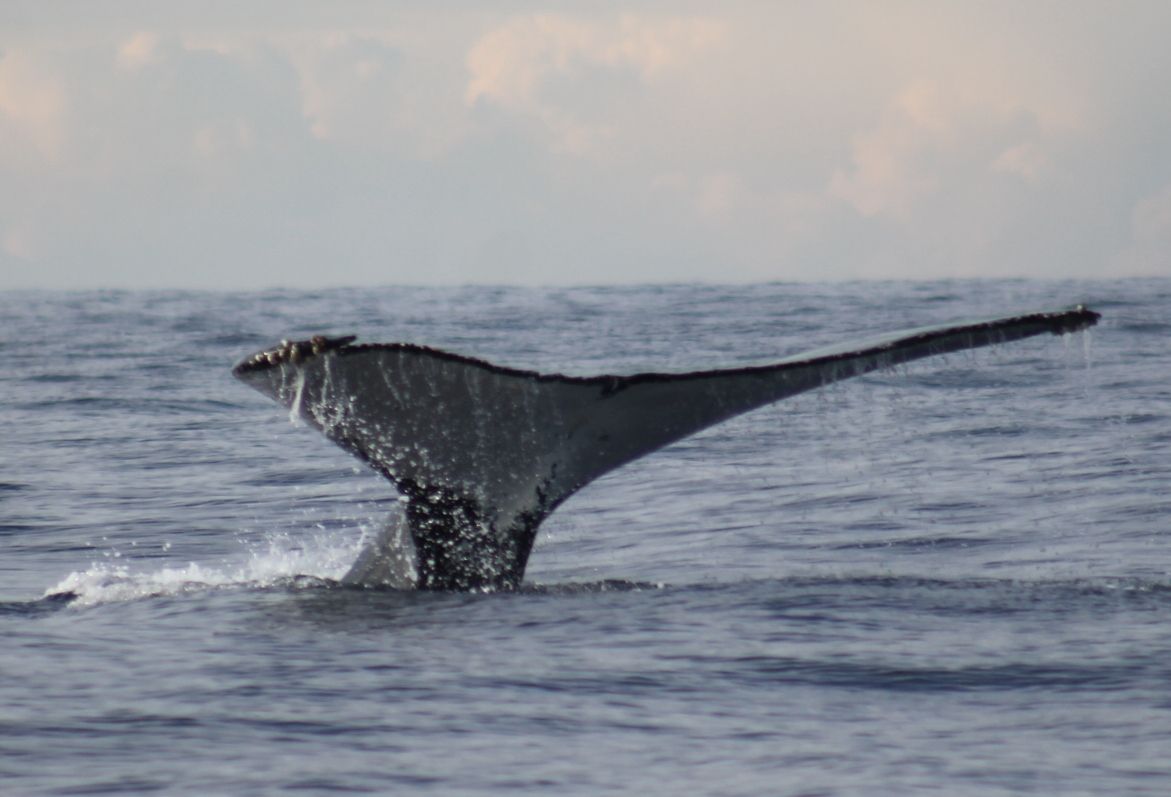
A J Guesdon photo
Avalon Community Garden
Avalon Community Garden’s primary purpose is to foster, encourage and facilitate community gardening in Pittwater on a not-for-profit basis.
The garden was started in 2010 by a group of locals who worked in conjunction with the support of Barrenjoey High School to develop a space that could be used by the local community, to grow
vegetables, herbs, plants and flowers, and practice sustainable gardening techniques to benefit its members and the community overall.
The garden has been very successful and has grown and developed since its inception, in terms of its footprint, infrastructure, variety of produce and diversity of members. The garden welcomes new members all year round. Levels of contribution range from multiple times a week, to once a month. Your contribution is always welcome, and it is acknowledged people will have varying levels of commitment.
We encourage you to join and start enjoying the following benefits associated with community gardening:
They provide benefits for individuals and for the community as a whole. Community gardens provide education on gardening, recycling and sustainable use of natural resources.
They develop community connections and provide a means of engaging youth, children, the elderly and the disabled and otherwise marginalised individuals in mutually enjoyable and rewarding activities, thus helping to develop more functional and resilient communities.
People involved in community gardens say they improve wellbeing by increasing physical activity and reducing stress, providing opportunities to interact meaningfully with new friends, give time for relaxation and reflection as well as an opportunity to improve their interconnectedness with nature.
To get involved take a look around the site, join the Facebook group and come along and visit on a Sunday morning between 10 and 12 at the garden within Barrenjoey High School on Tasman Road, North Avalon.
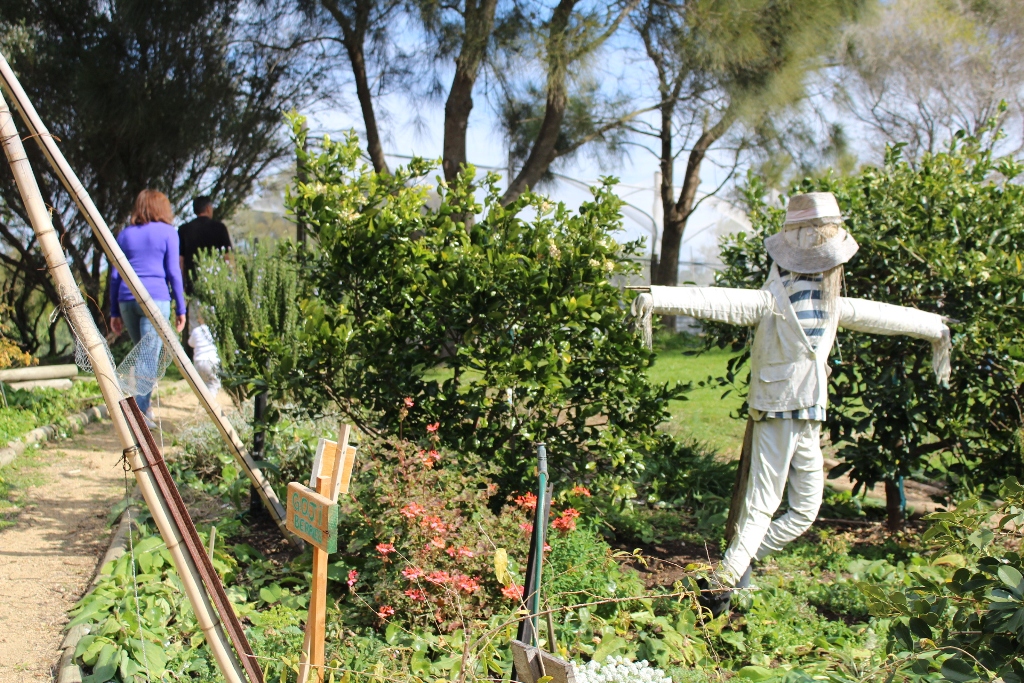
Wanted: Sydney's Precious Woody Elders
- A home - birds, bats, frogs, possums and gliders and reptiles will live in and on these stags
- A nursery - the hollow cavities in particular provide a place for some of our favourite creatures like owls and parrots (including some Threatened species) to lay eggs and raise young
- A snack - invertebrates, fungi, mosses and lichen will feed upon decaying wood, and so in turn provide food for our wildlife
- A safe lookout - stags often give unique vantage points for wildlife, especially raptors to look for prey
- are in Sydney
- are at least 85 to 95 cm around at chest height
- have at least one hollow/cavity of 40cm or larger at the entrance
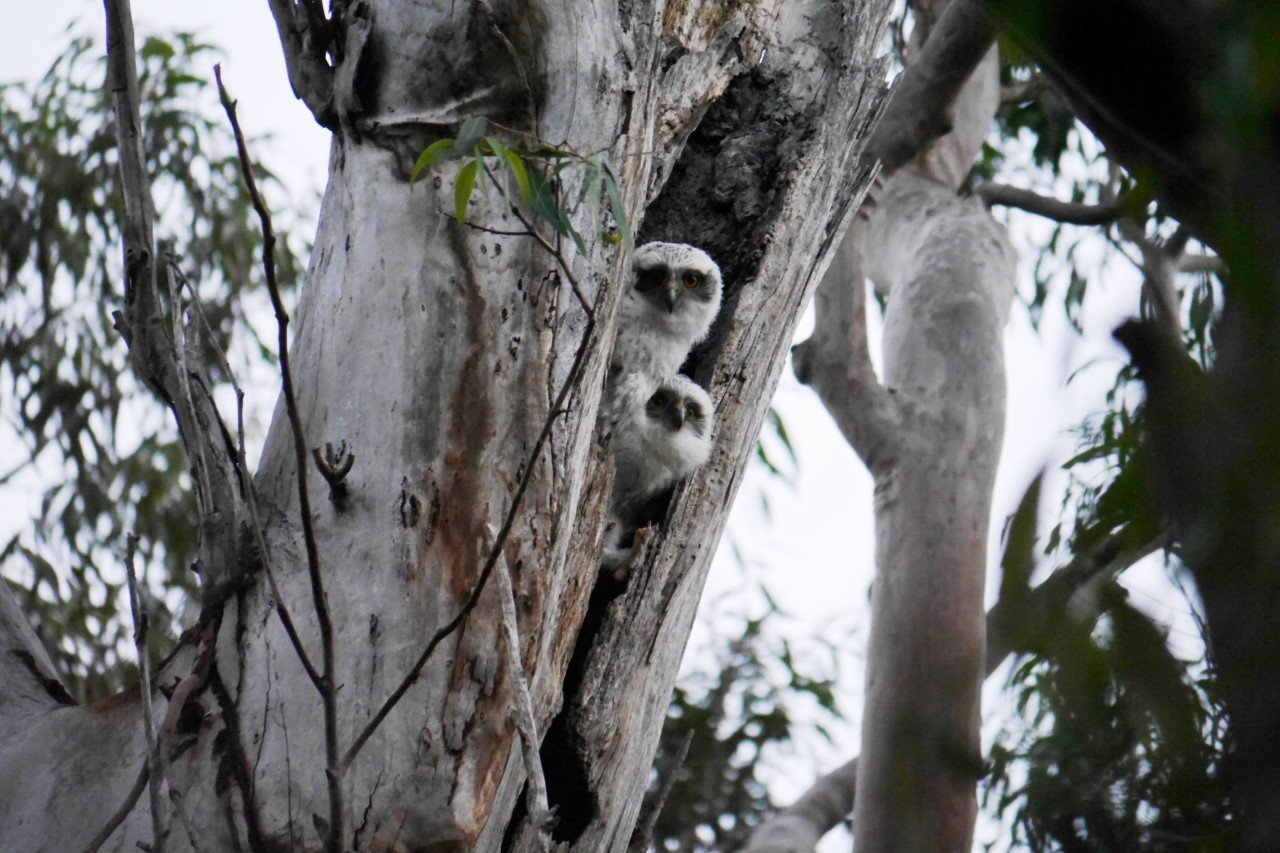
BirdLife Australia Autumn Survey Time
- Breeding behaviours - If you see a bird carrying nesting materials, sitting on a nest or feeding chicks, let us know. Select the option under 'Breeding Activity' that best matches your observation (remember to keep your distance though from birds who are breeding. We don't want to disturb any nests. Be sure to limit your observations and don't get close enough to scare a bird off it's nest.)
- Aggressive interactions – Let us know if you have observed any species initiate interactions with other birds and whether this interaction could be classed as aggressive – you can do this in the sighting details tab using the specific species interactions option.
- Have you seen any birds feeding on the native plants in your garden? If so – who was dining on what? – you can tell us in the notes section when you record the species you have observed under “sighting details”
- Have any birds been dabbling in some Oscar-worthy acting? – tell us about the weird and wonderful things your backyard birds have been up to you using the notes section in the sighting details tabs.
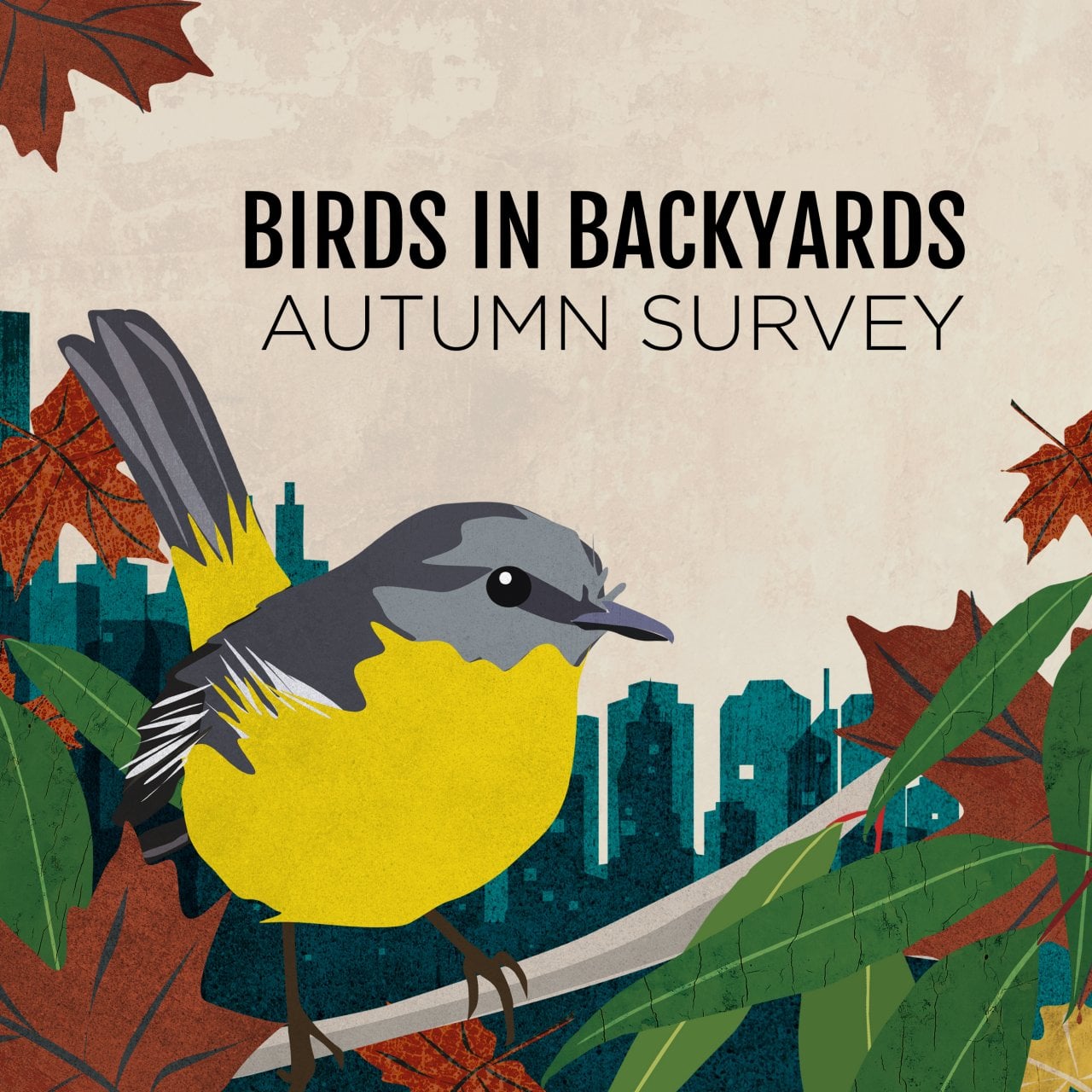
Narrabeen Lagoon Clean Up: March 28
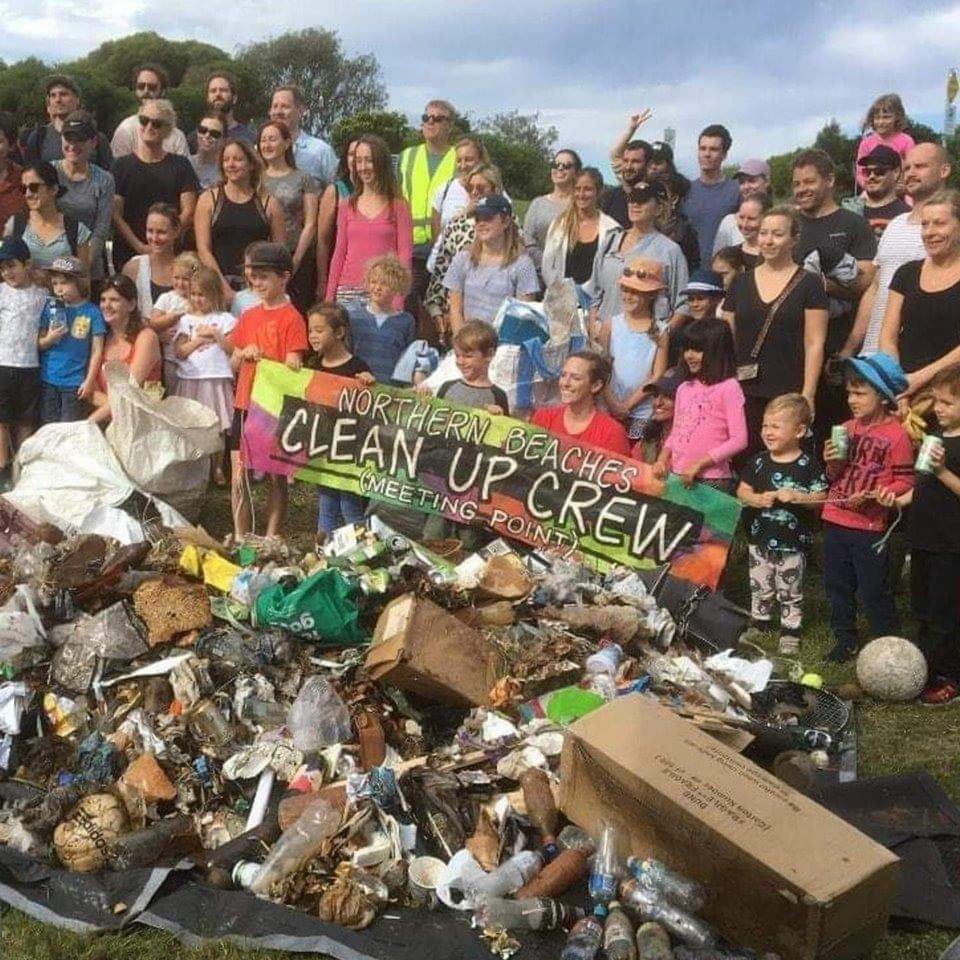
NSW To Drive Clean Industrial Revolution
NSW is set to become a world leader in low emission industries thanks to an unparalleled $750 million NSW Government program.
Energy Minister Matt Kean said the Net Zero Industry and Innovation Program is about coinvesting with industry to reduce our carbon emissions and develop low emissions technologies for the future.
“NSW was one of the first jurisdictions in the world to set a net zero objective, but we must get there in a way that grows the economy, makes our businesses and industry more competitive and puts us ahead of the pack in the low carbon global economy,” Mr Kean said.
“This $750 million program will support the development of new clean technologies, create world-leading centres of research and development and help existing industries future-proof their operations.”
Funding will focus on three key areas:
- $380 million to support existing industries to re-tool with low emissions alternatives and future proof their businesses;
- $175 million to set up low carbon industries such as green hydrogen to create the jobs of the future; and,
- $195 million to research and develop new clean technologies so we decarbonise in ways that grow the economy.
“Almost 30 per cent of our State’s carbon emissions are created by our top 55 industrial facilities, which are critical contributors to the NSW economy,” Mr Kean said.
“Supporting their move to cleaner equipment, technology and processes will significantly reduce emissions, while helping to protect jobs and maintain a resilient economy.
“Our landmark Electricity Infrastructure Roadmap will give NSW some of the cheapest, cleanest most reliable energy in the world.
“This program will build on that to help create the jobs of the future and drive a clean industrial revolution.”
The program is a cornerstone element of the NSW Government’s Net Zero Plan Stage 1: 2020-2030 and leverages existing NSW Government initiatives including Renewable Energy Zones, and Special Activation Precincts. Expressions of interest for the program will open in April, with businesses and industry encouraged to jump online and register.
For more information visit www.energysaver.nsw.gov.au/netzeroindustry
Tiny Turtles Turn Up Near Evans Head
Furious flipper action has been seen on a remote beach near Evans Head as tiny sea turtle hatchlings emerged from their buried nest and made a break for the ocean.
Andy Marshall from the National Parks and Wildlife Service (NPWS) said more than 100 Green Turtles hatched last week and their first moments were caught on camera by a local photographer coincidently walking the beach.
“These eggs have been incubating underneath the sand since around December and the hatchlings all emerged over a few hours in the early dawn,” said Mr Marshall.
“NPWS and NSW TurtleWatch are keeping a keen eye on around 7 more sea turtle nests along the coast as they should also hatch over the next few months.
“Along the NSW coast we expect the hatchlings will either be green turtles (Chelonia mydas) like the ones we saw at Evans Head or the endangered loggerhead turtle (Caretta caretta), both are generally around 5cm in length when born.
“If anyone sees a hatchling please don’t pick it up or interfere with its path to the sea, instead report it immediately to NPWS or NSW TurtleWatch so we make sure these little ones make it safely to the water,” Mr Marshall said.
Holly West from NSW TurtleWatch says early reports and information from the public is vital in being about to monitor these hatchlings.
“With such a large coastline to cover it is likely that we could have missed some nests being laid and may miss them hatching so public help at this time is vital,” said Ms West.
“Hatchlings should emerge at night as they are safer from predators and the heat of the sand but there are of course always stragglers, so we are asking people to keep their eyes peeled, especially close to sunset and sunrise.
“As well as reporting all sightings, you can help these baby turtles by removing your rubbish from the beaches, drive slowly along the beaches, and stay off the dunes,” Ms West said.
If you find a sea turtle hatchling along the beach please notify NSW TurtleWatch immediately on 0468 489 259, or contact NPWS on 1300 0PARKS.
NSW TurtleWatch has been developed by Australian Seabird Rescue, in partnership with NSW Government's Saving Our Species program.
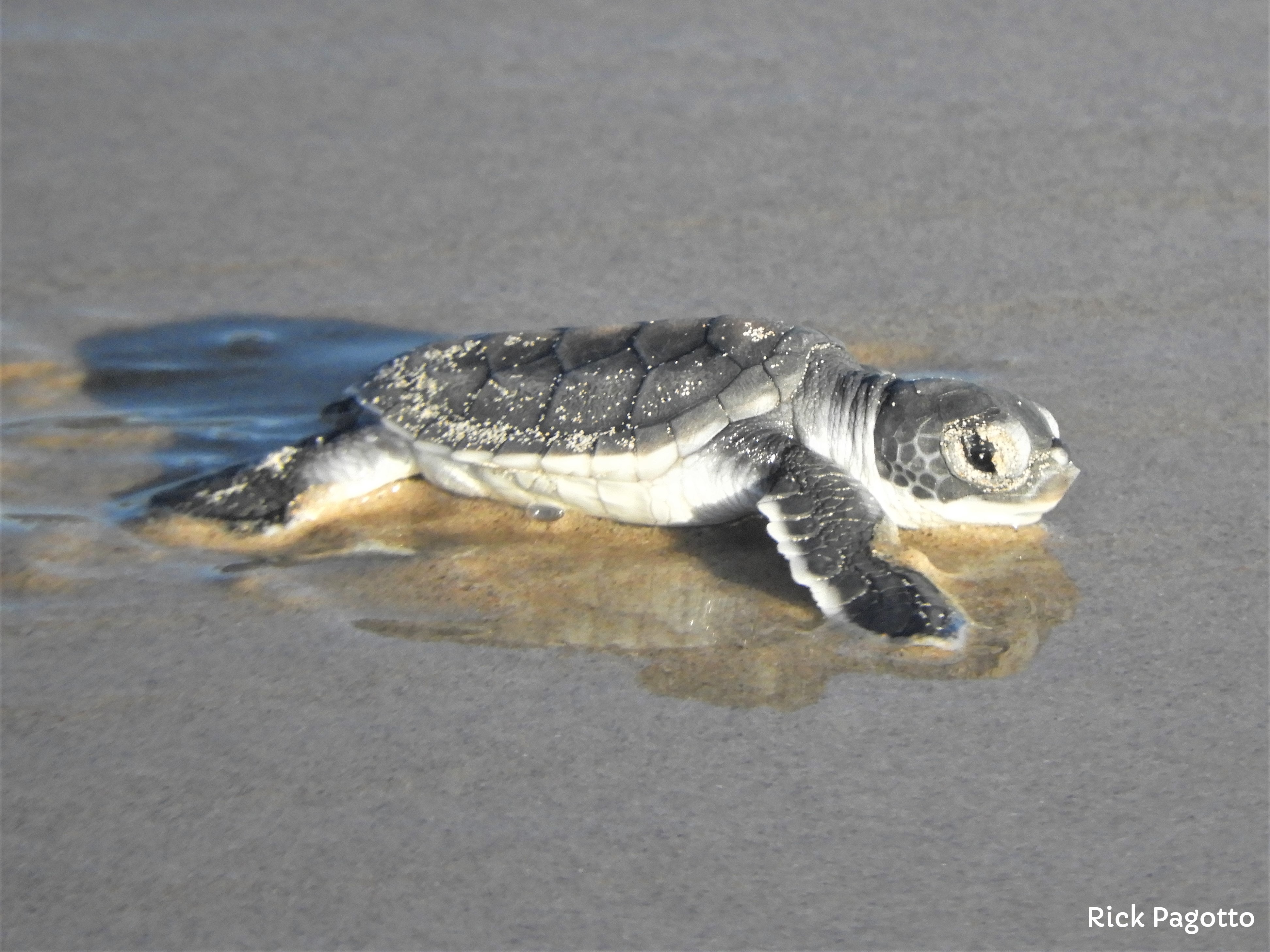
Eucalypt Dieback Gets Research Funding
March 10, 2021
Environment Minister Matt Kean today announced the awarding of nearly $1.2 million in research grants for one of the State's most damaging ecological issues, eucalypt dieback.
"If you've noticed pale-grey tree skeletons in the landscape – such as those along Kosciuszko Road on the Monaro Plain between Cooma and Jindabyne – that's dieback," Mr Kean said.
"These sick and skeletal trees are increasingly emerging across our State's landscape, and we don't know exactly why."
Dieback has killed millions of trees over a relatively short timeframe, damaging ecosystems and decreasing biodiversity. It's occurred across New South Wales, from near Bourke to the New England Tablelands, North Coast, Sydney's hinterland and down to the Snowy Mountains.
"By engaging some of the country's best scientific minds we are hoping to find ways to remedy the current dieback areas and prevent future outbreaks," Mr Kean said.
The 6 grantees in collaborations, led by universities and the CSIRO, have each been awarded up to $200,000 in funding.
Drought, insects, soil microbes and climate change are all thought to contribute to dieback, but without further research, it's difficult to address.
Dieback occurs when eucalypt trees lose leaves and die. It can happen to trees on their own, in groups, or in natural bushland. First noticed in small patches in the 1940s, dieback has increased significantly since around 2006.
A total of $1,197,911 million in grants was awarded to research collaborations at the Australian National University, the CSIRO, University of New England, Macquarie University and Western Sydney University.
Learn more about environmental research and grants awarded online.
Sentence For Fake Information About Asbestos-Contaminated Waste Disposal
March 12, 2021
A contractor who was paid nearly a quarter of a million dollars to take asbestos contaminated soil to a lawful landfill has been handed a 12-month term of imprisonment, to be served in the community, for faking waste disposal dockets.
Paul Mouawad was sentenced in the Land and Environment Court on 26 February 2021 following prosecution by the NSW Environment Protection Authority (EPA) over the disposal of 1,400 tonnes of waste containing asbestos.
An investigation by the EPA found 134 truckloads of asbestos-contaminated soil were collected from a building site in Darlington central Sydney in June and July 2016, but only one truckload was lawfully disposed of at the Elizabeth Drive Landfill at Kemps Creek.
The court heard that Mr Mouawad supplied 29 fraudulent waste disposal dockets and a fake Ticket List Report to the construction company engaged on the building site in an attempt to show the asbestos waste was disposed of lawfully, at a licensed landfill.
The EPA told the court that Mr Mouawad’s actions concealed the true location of the asbestos waste posing “indeterminable risks to the environment and human health, now and potentially, into the future”.
The EPA submitted the offences were aggravated by Mr Mouawad’s disregard for public safety and the planned and organised nature of the crime. The investigation revealed that in the lead up to the offences, Mr Mouawad had purchased a thermal printer, which he used to create falsified waste disposal dockets.
Justice Nicola Pain directed Mr Mouawad, who pleaded guilty to two charges of knowingly supplying false and misleading information about waste, to serve his 12-month term of imprisonment via an intensive correction order in the community. She also ordered Mr Mouawad to perform 250 hours of community service work, not commit any offences and pay the EPA’s legal costs of $60,000.
Each offence carried a maximum penalty of $240,000 or imprisonment for 18 months or both for an individual.
The company Mr Mouawad was employed by, Aussie Earthmovers Pty Ltd, was convicted and fined $450,000 on two charges of knowingly supplying false and misleading information about the disposal of the waste in November 2020, following a separate EPA prosecution.
EPA Director Major Compliance and Investigations Greg Sheehy said rogue operators caused harm to both honest companies and the environment.
“The sentence shows that criminal behaviour does not pay,” he said. “The EPA will pursue and prosecute offenders who try to make a quick buck by damaging the environment.”
NSW Police separately charged Mr Mouawad with defrauding the construction company by providing the false invoices. He pleaded guilty to a fraud charge in September 2018 and was sentenced to a 15-month intensive correction order following an appeal to the NSW District Court. He was also ordered to repay the construction company $225,056. The compensation has not yet been paid.
Mr Mouawad is also being prosecuted by the EPA for three additional offences, which allege waste, including waste containing asbestos, was illegally disposed of at Arcadia in Sydney’s north-west. He has pleaded not guilty to those matters, which are still before the Court.
Design And Place State Environmental Planning Policy (SEPP): Open For Feedback Until March 31
'The Design and Place SEPP puts place and design quality at the forefront of development. Our shared responsibility to care for Country and sustain healthy, thriving communities underpins the policy. The SEPP spans places of all scales, from precincts, significant developments, and buildings to infrastructure and public space. ''The public exhibition will allow us to work closely with state government, local councils, industry peak bodies and communities. This process will inform the development of the Design and Place SEPP and safeguard our shared values for future development in NSW. We will draft the policy in 2021, following the review of the formal submissions and feedback. Submissions are open from now until 31 March 2021. 'The final Design and Place SEPP will go on public exhibition later in 2021 to provide more opportunities for feedback. We will also develop supporting guidance and tools alongside the policy. These include a revision to the Apartment Design Guide, improvements to the Building Sustainability Index (BASIX) tool and the development of a new Public Space and Urban Design Guide. '
Worth Noting: Australian Car Sales Statistics 2020
- There were 1,062,867 new vehicles sold in Australia 2019
- New car sales in Australia dropped 8% down from 2018, making it the lowest since 2011
- Toyota was the top-selling car brand in 2019, with 205,766 total sales
- SUVs accounted for 45.5% of new car sales in 2019
NSW Department Of Planning Projects On Exhibition: Open For Comment
- your name and address, at the top of the letter only;
- the name of the application and the application number;
- a statement on whether you ‘support’, ‘object’ to the proposal or are only making a comment;
- the reasons why you support or object to the proposal; and
- a declaration of any reportable political donations you made in the previous two years.
- > A new 500/330 kilovolt (kV) substation located within Bago State Forest and adjacent to TransGrid’s existing Transmission Line 64 (Line 64)
- > Two 330 kV double-circuit overhead transmission lines, approximately nine kilometres long, linking the Snowy 2.0 cable yard in Kosciuszko National Park (KNP) to the new substation
- > An overhead transmission line connection between the substation and Line 64
- > Construction of new access tracks and upgrade of existing access tracks where required to facilitate the construction of the transmission lines and substation and service ongoing maintenance activities
- > Establishment of temporary sites and infrastructure needed during construction including crane pads, site compounds, a helipad, equipment laydown areas, and tensioning and pulling sites for the stringing of overhead conductors and earthwires.
- increased open cut coal extraction within the approved Mount Pleasant Project (EPBC 2011/5795) development area, including accessing deeper coal reserves in North Pit;
- staged increase in the extraction, handling and processing of ROM coal up to 21 Mtpa (i.e. progressive increase in ROM
- coal mining rate from 10.5 Mtpa over the Project life); and
- continued use of the controlled release dam and associated infrastructure that was approved through Bengalla Mine State and Federal approvals.
- Under the proposed Action, mining operations at the higher production rate would extend to 22 December 2048
Bushcare In Pittwater
Where we work Which day What time
Avalon
Angophora Reserve 3rd Sunday 8:30 - 11:30am
Avalon Dunes 1st Sunday 8:30 - 11:30am
Avalon Golf Course 2nd Wednesday 3 - 5:30pm
Careel Creek 4th Saturday 8:30 - 11:30am
Toongari Reserve 3rd Saturday 9 - 12noon (8 - 11am in summer)
Bangalley Headland 2nd Sunday 9 to 12noon
Bayview
Winnererremy Bay 4th Sunday 9 to 12noon
Bilgola
North Bilgola Beach 3rd Monday 9 - 12noon
Algona Reserve 1st Saturday 9 - 12noon
Plateau Park 1st Friday 8:30 - 11:30am
Church Point
Browns Bay Reserve 1st Tuesday 9 - 12noon
McCarrs Creek Reserve Contact Bushcare Officer To be confirmed
Clareville
Old Wharf Reserve 3rd Saturday 8 - 11am
Elanora
Kundibah Reserve 4th Sunday 8:30 - 11:30am
 Mona Vale
Mona Vale Mona Vale Beach Basin 1st Saturday 8 - 11am
Mona Vale Dunes 2nd Saturday +3rd Thursday 8:30 - 11:30am
Newport
Bungan Beach 4th Sunday 9 - 12noon
Crescent Reserve 3rd Sunday 9 - 12noon
North Newport Beach 4th Saturday 8:30 - 11:30am
Porter Reserve 2nd Saturday 8 - 11am
North Narrabeen
Irrawong Reserve 2nd Saturday 2 - 5pm
Palm Beach
North Palm Beach Dunes 3rd Saturday 9 - 12noon
Scotland Island
Catherine Park 2nd Sunday 10 - 12:30pm
Elizabeth Park 1st Saturday 9 - 12noon
Pathilda Reserve 3rd Saturday 9 - 12noon
Warriewood
Warriewood Wetlands 1st Sunday 8:30 - 11:30am
Whale Beach
Norma Park 1st Friday 9 - 12noon
Western Foreshores
Coopers Point, Elvina Bay 2nd Sunday 10 - 1pm
Rocky Point, Elvina Bay 1st Monday 9 - 12noon
Gardens And Environment Groups And Organisations In Pittwater
Pittwater Reserves

NSW State Water Strategy: Have Your Say
Senate Inquiry Into Environment Protection And Biodiversity Conservation Amendment (Regional Forest Agreements) Bill 2020
''This Bill will affirm and clarify the Commonwealth’s intent regarding Regional Forest Agreements to make it explicitly clear that forestry operations in a Regional Forest Agreement region are exempt from Part 3 of the EPBC Act, and that compliance matters are to be dealt with through the state regulatory framework.
Requiring native forestry operations to seek EPBC Act approval would create operationally unviable delays in planned harvesting operations that have already been subjected to significant environmental planning and approvals and create congestion in the approvals pipeline.
This is achieved by removing the ambiguity of what it means to be “undertaken in accordance with a Regional Forest Agreement” (subsection 38(1) of the EPBC Act), which a recent Federal Court decision (Friends of Leadbeater’s Possum Inc v VicForests (No 4) [2020] FCA 704 has shown is not explicit with respect to the Commonwealth’s intended meaning.
Furthermore, the operation of subsection 38(1) is just one of several legal questions considered by Justice Mortimer’s judgment and subsequent appeal. There is no guarantee that the appeal will deal with the substantive question about the operation of subsection 38(1).
The Independent review of the EPBC Act Interim Report (Samuel 2020) recommended addressing this uncertainty:
- “During the course of this Review, the Federal Court found that an operator had breached the terms of an RFA and should therefore be subject to the ordinary controlling provisions of the EPBC Act. Legal ambiguities in the relationship between EPBC Act and the RFA Act should be clarified, so that the Commonwealth’s interests in protecting the environment interact with the RFA framework in a streamlined way.” (page 10), and
- “The EPBC Act recognises the RFA Act, and additional assessment and approvals are not required for forestry activities conducted in accordance with an RFA (except where forestry operations are in a World Heritage property or a Ramsar wetland). These settings are colloquially referred to as the 'RFA exemption', which is somewhat of a misnomer.” (page 60).
The Interim Report also made it clear that under a regional model of empowering the states, the oversight functions would be the responsibility of the states through accredited frameworks (as occurs with Regional Forest Agreements):
“For projects approved under accredited arrangements, the accredited regulator would be responsible for ensuring that projects comply with requirements, across the whole project cycle including transparent post-approval monitoring, compliance and enforcement. The Commonwealth should retain the ability to intervene in project-level compliance and enforcement where egregious breaches are not being effectively enforced by the accredited party.” (page 55).
''The Commonwealth must act urgently to resolve this uncertainty to ensure that the tens of thousands of jobs that depend on Australia’s native forestry operations are not exposed to the sort of crisis now facing Victoria’s native hardwood sector. This amendment Bill will achieve this outcome.''
- First reading: Text of the bill as introduced into the Parliament
- Third reading: Prepared if the bill is amended by the house in which it was introduced. This version of the bill is then considered by the second house.
- As passed by both houses: Final text of bill agreed to by both the House of Representatives and the Senate which is presented to the Governor-General for assent.
A manatee with 'TRUMP' scraped into its back was itself disturbing. But it reflects a deeper environmental problem
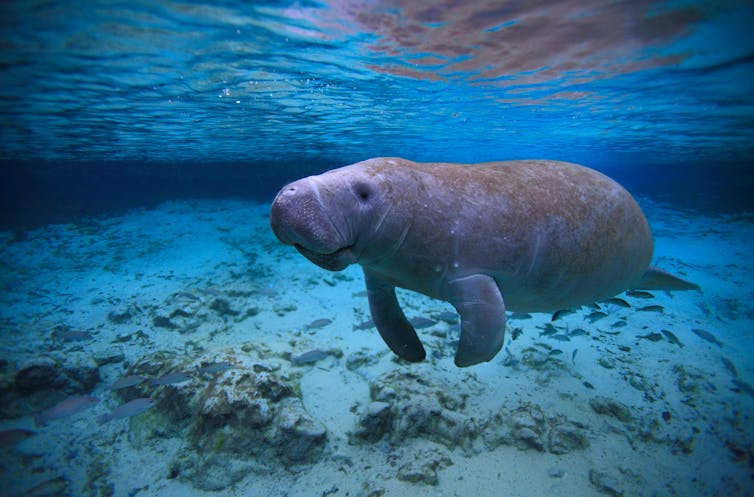
Days after US rioters stormed Capitol Hill in January, a manatee was found in a Florida river with the word “TRUMP” scraped into its back. The aftermath of the disturbing incident revealed a pervasive left-right divide that has long plagued environmental debate.
Polarised views dominate discussion on critical issues such as climate crisis and biodiversity protection. Typically, the left calls for more environmental protections, and the right claims these protections threaten economic prosperity or individual rights.
The election of the Biden administration raised hopes of a new dawn in environmental protections. Our research, however, suggests entrenched left-right views will continue to stymie effective environmental action in the United States – just as they do in Australia.
That’s because focusing on localised protections or individual rights leaves intact a cultural blind spot that conceals systemic issues threatening nature. Tackling these issues requires confronting environmental damage to which we all contribute.
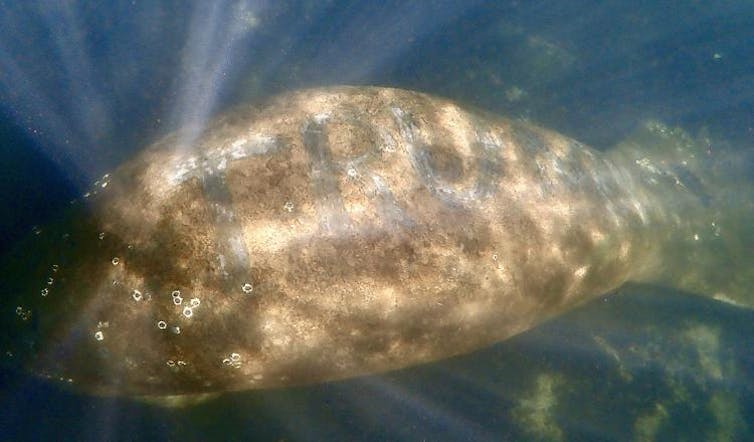
The Manatee Incident
The Florida manatee is a large marine mammal, and one of the original species listed as endangered under the 1966 US Endangered Species Act. The animals are similar to dugongs found in Australia.
The January 11 manatee incident was quickly co-opted into the US political debate. Some on the left accused Trump supporters of inflicting the damage. Right-wing observers downplayed the seriousness of the incident and suggested claims of abuse were manufactured by the left out of hatred for Trump.
Others framed the incident as typical of stereotypes of Florida as home to reactionary politics and “trashy” culture.
It may be tempting to dismiss the incident as unique to the Trump era or Florida itself. But doing so risks ignoring important lessons. Our research shows how framing such events as political left-right issues prevents us from recognising the deeper causes of environmental crises.
Read more: Dugongs: looking to the gentle sea creature's past may guard its future
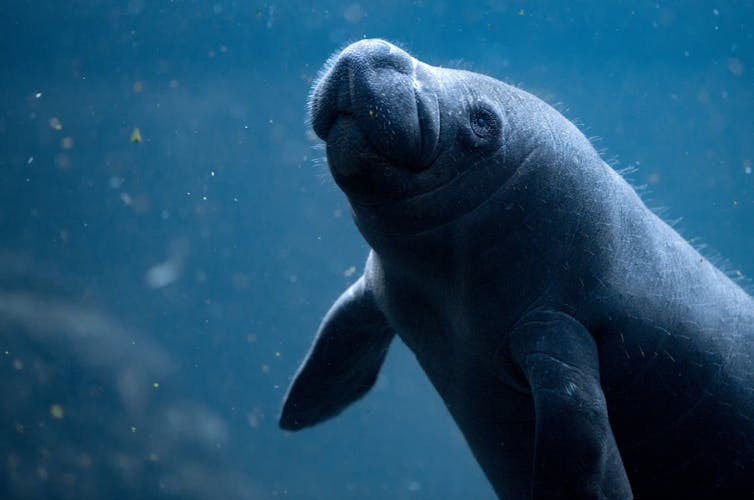
The Bigger Picture
Media and politicians in the US and elsewhere often characterise the environmental threat as one posed by individuals. But in most cases, including manatees, threats extend far beyond a single bad act.
Before colonisation, wetlands accounted for up to two-thirds of Florida’s land mass. But rampant coastal development over the past 150 years destroyed more than 60% of these wetlands – dismantling habitat and preventing manatees from reaching warm springs needed to survive winter. Also, human climate disruption has led to frequent severe “red tide” algal blooms, which poison manatees.
But these broader threats to manatee survival are largely ignored by news media, environmental actors and even protection laws. Instead, the left tends to focus on individual threats, and the right on individual human or economic rights.
For example, in response to January’s incident, local news outlets published calls by environmental advocates to ban human contact with manatees. This approach echoes existing state and federal laws that prohibit people from harassing, hurting or killing manatees, but fail to protect the ecosystems manatees rely upon to survive.
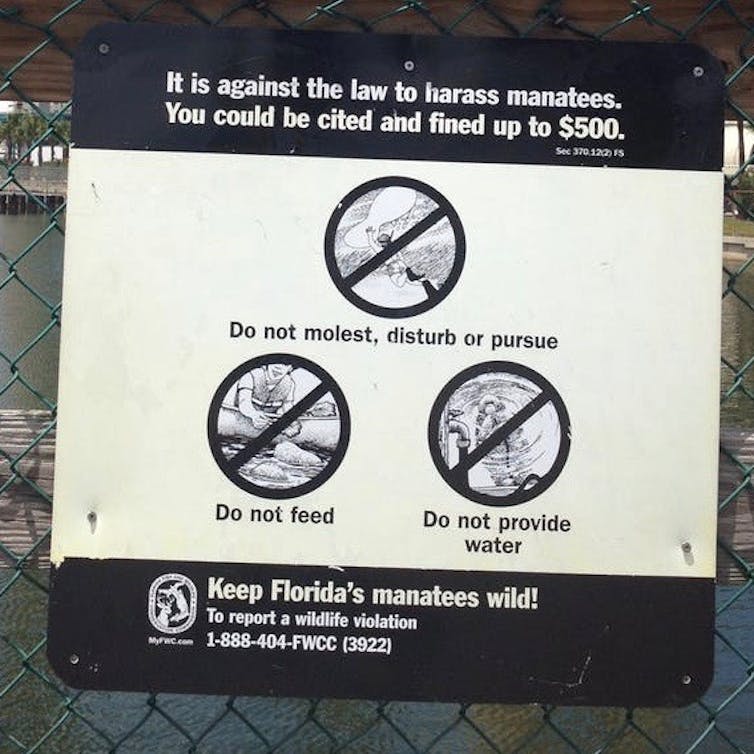
Still, such manatee protection efforts meet backlash from the right. For example, in 2017, right-wing lobbyists successfully pressured the US government to downgrade the status of manatees from “endangered” to “threatened”, thus weakening manatee protections. The move was motivated by a desire to protect individual property and economic rights – in this case, development in Florida’s wetlands.
Clearly, manatees – and other vulnerable species – are threatened by the tireless expansion of human impact on every aspect of the ecosystems they need to survive. This includes our transport systems, housing, energy generation and over-consumption.
But debate and action on such issues tends to ignore the interconnected threats. For example, as coastal development in Florida destroyed warm-water springs, manatees have become reliant on warm waste water flowing from nearby power plants. Conservationists successfully sued to have manatee sanctuaries created around these artificial discharges, despite the broader damage the industries wreak on the planet.
Similar framing is seen in Australia where, for example, battles over protected marine zones largely revolve around how much commercial fishing is allowed. This obscures other systemic threats to oceans that threaten not just fish numbers, but the oceans’ abilities to support all life – including climate disruption, agricultural runoff, water pollution, and overfishing.
Environmental well-being requires reconsidering how our societies function. Instead, debate is often fixated on less central issues, such as how well or poorly our environmental efforts compare internationally.
Read more: Biden has pledged to advance environmental justice – here's how the EPA can start

Inextricably Linked
As COVID-19 has shown, humans and our systems are inseparable from nature. But global left-right environmental debate largely ignores this.
Instead, there’s a widely held belief humans are separate from, and even superior to, nature. This “human exceptionalism” can be traced back to Enlightenment thought and Judeo-Christian tradition that privilege humans above other species, and the planet as a whole.
As a result of this blind spot, personal economic opportunity is often seen as more important than ecological balance. And those who seek to protect nature often mobilise to protect specific areas or species from a narrow threat. This is compounded by an absence of institutional systems to address intertwined issues threatening large ecosystems.
Looking past the false separation of humans from nature is necessary, but confronting. It means seeing, questioning, and addressing the systems many of us – both on the left and right – take as a given.![]()
John Carr, Senior Lecturer, Environment and Society Group, UNSW and Tema Milstein, Associate Professor of Environment & Society, UNSW
This article is republished from The Conversation under a Creative Commons license. Read the original article.
Scientists used 'fake news' to stop predators killing endangered birds — and the result was remarkable

Animals, including humans, depend on accurate information to navigate the world. But we can easily succumb to deliberate misinformation or “fake news”, fooling us into making a poor choice.
The concept of fake news came to the fore during the term of former US president Donald Trump. It became so prevalent, it was named the Macquarie Dictionary’s word of the decade
In a new paper out today we show how a form of fake news can be deployed to help save vulnerable wildlife. We protected endangered shorebirds by spreading misinformation — in the form of bird smells — to deceive predators. This helped reduce the number of birds lost, without using lethal force.
To be honest, when we began working on the idea ten years ago it seemed a little crazy. But after seeing how fake news messes with the minds of both humans and animals, it now makes a lot of sense.
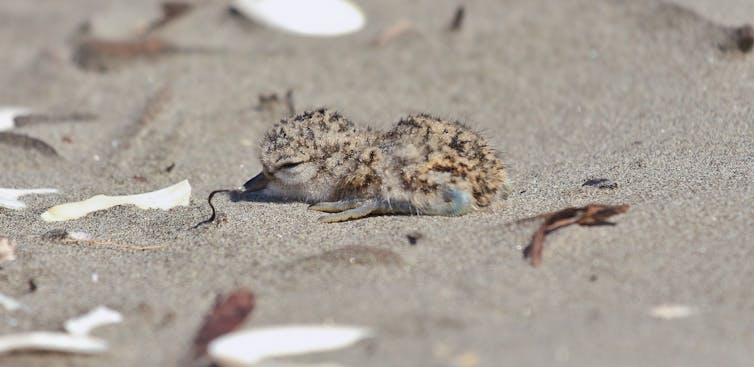
The Problem With Predators
Introduced or “alien” predators are species such as rats, cats and foxes, which have been introduced to new environments and kill local wildlife. If local species have not evolved with such predators — and so learned to evade them or ward them off — the damage can be devastating.
Alien predators have far more impact than native ones and are a major driver of extinctions. In Australia alone, cats threaten the survival of more than 120 listed species, while foxes threaten 95 species. In the South Pacific the threat is even greater.
But killing predators is a blunt and often ineffective tool. Too often, control techniques such as baiting, trapping and shooting can’t reduce predator numbers enough to protect vulnerable prey.
In other circumstances, lethal control may not be possible or socially acceptable. This might occur when the problem predator is a native species (such as foxes in the United Kingdom) or where alien predators such as feral pigs are also a food resource for local people.
That’s why it’s important to examine alternative ways to protect vulnerable species.
Read more: Australia's threatened birds declined by 59% over the past 30 years
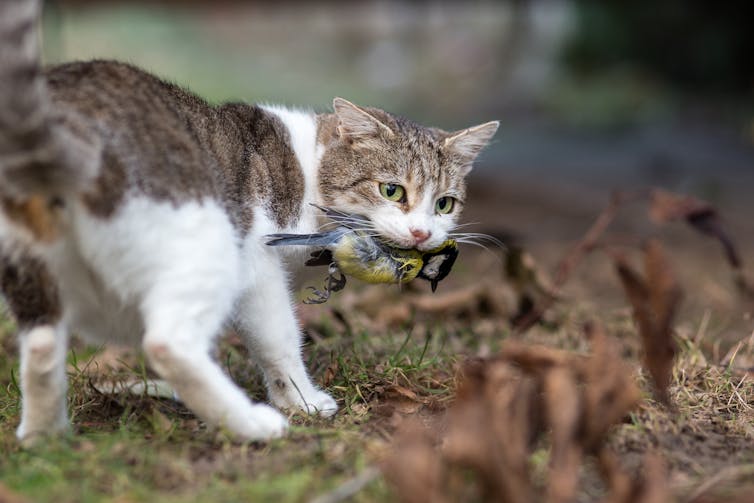
New Zealand’s Precious Shorebirds
In New Zealand, 59 bird species have become extinct since humans arrived and many more close to being lost. Introduced predators contribute substantially to this problem.
Predators such as hedgehogs, cats and ferrets were introduced to New Zealand in the 1800s. They are especially common in our study area, the braided riverbed landscapes of the Mackenzie Basin on New Zealand’s South Island. There, they eat eggs and kill endangered shorebirds such as banded dotterel, plovers, wrybill and the South Island pied oystercatcher.
The birds evolved with avian predators, and have learnt to hide from them by building camouflaged nests among pebbles on the river shores.
But this tactic does not work against introduced predators. Odours emanating from the shorebirds’ feathers and eggs attract these scent-hunting mammals, which easily find the nests.
Tricked You!
Our research set out to undermine the predators’ tactics. We worked closely with Grant Norbury and others from Manaaki Whenua Landcare Research in New Zealand.
We distributed fake news — in the form of nest-like odours — that suggested to predators the shorebirds had begun to nest, even though they were yet to arrive.
First, we distilled odours extracted from the feathers and preen glands of three bird species — chickens, quails and gulls. In this case, any bird species could be used to produce the scent. (Watch a video of the process here). The result smelled a lot like a chicken coup or aviary — unmistakable to the human nose.
Five weeks before the shorebirds arrived for their breeding season in 2016, we mixed the odours with Vaseline and smeared the concoction on hundreds of rocks over two 1,000-hectare study sites. We did this every three days, for three months.
The predators were initially attracted to the odours. But within days, after realising the scent would not lead to food, they lost interest and stopped visiting the site.

The shorebirds then arrived at Mackenzie Basin at their normal breeding time, and began building nests and laying eggs. At control sites where our “fake news” had not been deployed, the predators ate eggs and birds at the usual rate. But at sites where we put out unrewarding bird odours, the results were dramatic.
The number of nests destroyed by predators almost halved. As a result, chick production was 1.7 times higher at treated sites compared to control sites over the 25-35 days of the nesting season.
We wanted to be sure our results were not due to lower predator numbers or different behaviour in some areas. So the next year, we flipped treatments at our sites and got the same result.
Read more: Predators, prey and moonlight singing: how phases of the Moon affect native wildlife
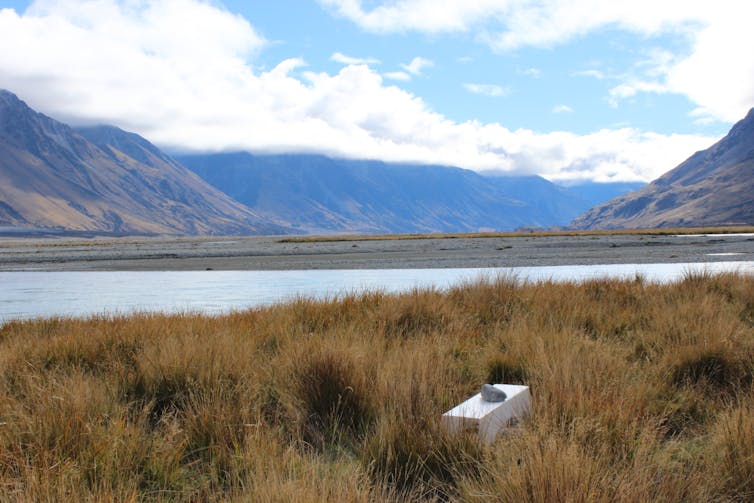
Using Fake News For Good, Not Evil
Our modelling predicts this fake news tactic would increase plover populations by about 75% over 25 years. By comparison, an absence of intervention would lead to a population decline of more than 40%.
Our results show the profound conservation potential of fake news tactics. The approach cost no more than a traditional lethal control program and delivered comparable benefits.
We hope the work will encourage others to consider manipulating the behaviour of introduced predators when lethal control options are too difficult or ineffective.![]()
Peter Banks, Professor of Conservation Biology, School of Life and Environmental Sciences, University of Sydney and Catherine Price, Postdoctoral Researcher in Conservation Biology, University of Sydney
This article is republished from The Conversation under a Creative Commons license. Read the original article.
The death of coal-fired power is inevitable — yet the government still has no plan to help its workforce
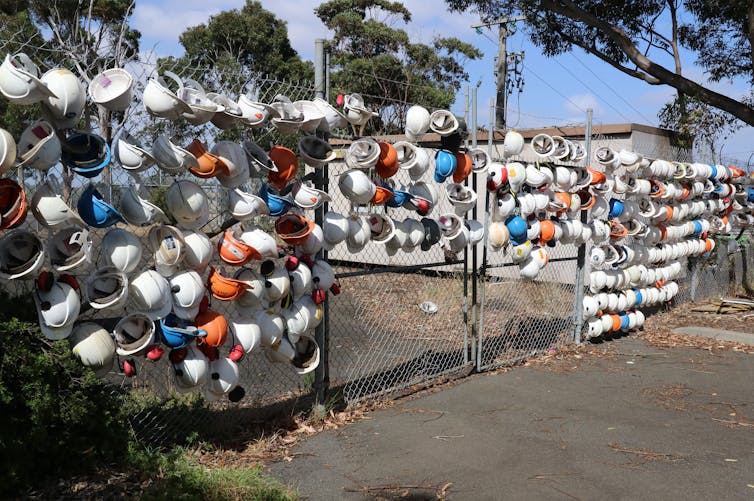
Yallourn power station — Australia’s oldest, dirtiest coal plant — will close four years ahead of schedule in 2028. Announcing the move this week, operator Energy Australia said it will build a giant energy storage battery on the site to make room for more renewables. This is a powerful statement about where our energy system is heading.
Yallourn has operated for 47 years burning brown coal. It supplies one-fifth of Victoria’s energy and employs 500 permanent workers and hundreds more contractors. It’s also responsible for 13% of Victoria’s emissions.
In response to the announcement, federal Energy Minister Angus Taylor said:
Our thoughts are with the workers, their families and local business owners who rely on the power station for their livelihoods.
So what, exactly, is the the federal government doing to help the 10,000 domestic coal workers set to lose their jobs when Yallourn and other coal power stations shut down? At the moment, the federal government isn’t offering anything more than platitudes.
Over the next 15 years, the Australian Energy Market Operator (AEMO) projects most of Australia’s 20-odd coal plants will also close. Australia urgently needs investment and policy solutions to manage this inevitable transition. Without it, workers and electricity consumers will be left dangerously exposed.
The Inevitable Demise Of Coal
Solar and wind energy are now the cheapest forms of new electricity generation. As the former chief executive of AEMO, Audrey Zibelman, stated last year:
It is inevitable […] we are at a position where the existing coal fleet is coming to the end of its technical life and is going to retire.
Renewable energy has grown to 25-30% of the market, placing enormous pressure on coal-fired generators and lowering their market share. In fact, a recent study estimates that by 2025, as many as five Australian coal power stations could be unprofitable.
At the last federal election, the Morrison government claimed 50% renewable energy by 2030 would be ruinous for our economy.
Now, several expert energy analysts estimate that renewable projects already in the pipeline could see 50% renewables occur as early as 2025.
Read more: Vital Signs: timing of Yallourn's closure shows it's high time for a carbon price
Australia Has No Plan
Australia is not well-prepared for the closure of coal power stations. It has no national climate and energy policy. And unlike nations such as Germany and Spain, there is no timetable for closures or agreements in place to manage the exit of coal power stations.
Under the National Electricity Rules, generators are required to give three years’ notice for a closure. But the penalties for failing to do so are not a significant deterrent relative to the incentive to stay in the market for as long as possible.
A recent Sydney Morning Herald report quoted an energy market source who said coal plant owners are playing a “game of chicken”. They are holding on and hoping another plant closes, which would tighten supply, raise electricity prices and improve the financial viability of remaining generators.
The closure of Yallourn is too far away to change the equation for other coal power stations at risk.
Without effective regulation or policy, regional coal communities are mostly left relying on the owners’ goodwill, or fear of reputational damage, to do the right thing.
Already, we’ve seen the damage planned and unplanned coal plant closures can have on workers and consumers.
After the Hazelwood power station in the Latrobe Valley closed in 2016 with just a few months’ notice, data presented to the Victorian parliament in 2019 showed just one in three workers had found full-time work and one in four were unemployed.
What’s more, electricity prices spiked once Hazelwood’s supply was pulled from the market – demonstrating the risks to electricity supplies and consumers when coal exits don’t happen in an orderly manner.
Regional coal communities need time to adjust to the energy transition. If a string of Australian coal stations close at short notice, the social and economic impacts could be devastating.
In the case of Yallourn, the Victorian government negotiated an agreement, including seven years’ notice of the closure and support for the workforce, such as re-training.
Read more: How Australia can phase out coal power while maintaining energy security
Some coal plant operators are also taking the lead. In 2017, AGL gave five years’ notice that the Liddell coal plant in the New South Wales Hunter Valley would close in 2022 (the shutdown has since been pushed back to 2023). The company is now investing in transition measures for the site and workforce.
Heavy-handed intervention by the federal government has made attracting investment harder for Liddell and could do the same for Yallourn.
Renewable energy already creates more jobs (just under 30,000) than the domestic coal sector. Most of these jobs are currently in construction, but by the mid-2030s as many as half could be in ongoing operation and maintenance as the fleet of renewable projects grows.
This number will increase further. But while renewables projects will create some new jobs in coal regions, most will be in other regional areas and the capital cities.
Read more: 45,000 renewables jobs are Australia’s for the taking – but how many will go to coal workers?
So What Needs To Happen?
It seems almost everyone recognises the reality of coal power’s inevitable demise — except the federal government.
AEMO projects a grid dominated by renewable energy by 2035. Almost all of Australia’s banks and insurers have committed to exit thermal coal between 2030 and 2035.
The NSW, Queensland and Victorian governments are establishing Renewable Energy Zones to fast-track the growth of renewable energy before coal plants retire. And there are initiatives to grow regional jobs such as the NSW Renewable Sector Board, the Latrobe Valley Authority) and collaborations such as the Hunter Jobs Alliance).
These are all important and meaningful initiatives. But without a national policy or a process for coal exits, they’re operating in a vacuum without timeframes.
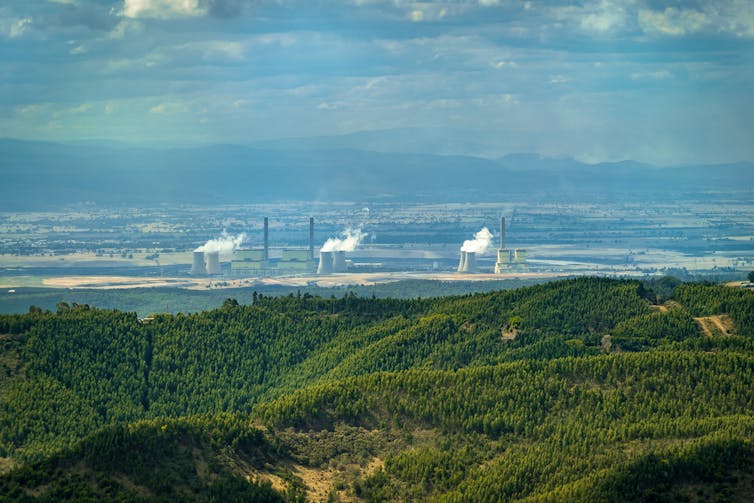
Australia should start looking to overseas experiences, where governments are establishing transition authorities and injecting funds to diversify regional economies and retrain workers. The European Union, for example, has set up a €17.5 billion (A$27 billion) Just Transition Fund. And national agreements between the government, industry, unions and communities to phase out coal have been negotiated in Germany and Spain.
There’s little prospect of this happening any time soon in the current Australian political climate, but a range of models have been advocated here. This includes auctions to stagger closures, or coal owners nominating a closure window and depositing money in a fund as insurance towards that commitment.
Whatever the model, a policy solution for the demise of coal is urgently needed across levels of governments, energy planners and local communities. Otherwise, it’s likely to be a bumpy ride for coal workers and the electricity system.
Read more: How to transition from coal: 4 lessons for Australia from around the world ![]()
Chris Briggs, Research Principal, Institute for Sustainable Futures, University of Technology Sydney
This article is republished from The Conversation under a Creative Commons license. Read the original article.
Vital Signs: timing of Yallourn's closure shows it's high time for a carbon price

If you ever doubted the price of renewable energy was falling so rapidly it would eventually replace fossil fuels, the expedited closure of the Yallourn coal-fired power plant should change that.
Energy Australia announced this week it would close the 47-year-old power station in Victoria’s Latrobe Valley in 2028 – four years earlier than expected – given the low price and high uptake of renewable energy.
This is good news for the environment. Yallourn is the nation’s most carbon-intensive generator. It accounts for 13% of Victoria’s greenhouse gas emissions and almost 5% of Australia’s total emissions.
But it also provides 22% of Victoria’s electricity and directly employs 500 people in a region already struggling with the transition away from fossil fuels. (Hundreds more jobs were lost when another Latrobe Valley coal-fired power station, Hazelwood, closed in 2017.)
Some of the impact may be mitigated by Energy Australia’s plan to build a 350 megawatt battery – 3.5 times the capacity of South Australia’s big battery in Hornsdale, larger than any now existing – near the company’s Jeeralang gas-fired power station in the Latrobe Valley.
Policy Hodgepodge
The crucial question in all of this is whether Australia’s coal-fired power stations are being retired too slowly – or potentially even too quickly.
It’s hard to know without a price on carbon to create a level playing field for renewable energy and fossil fuels.
We need a carbon price that reflects the “social cost of carbon”. The best evidence is this is about US$51 per metric ton.
What we have instead is a hodgepodge of clumsy government interventions on both sides of the ledger.
Yes, there are subsidies for renewable generation such as wind and solar.
But there is perhaps as much as A$12 billion a year in implicit subsidies for fossil fuels. These subsidies stem from things such as the fuel tax credit scheme, aviation fuel excise concession, accelerated depreciation through effective life caps on power plants, fringe benefits tax concessions, uplift provisions in the petroleum resources rent tax, and more.
Huge Uncertainty
All of this creates huge uncertainty about if and when Australia’s remaining 16 coal-fired power plants will close. When will their workers need transition assistance to begin? Are we sending the right price signals for those considering investing in different forms of power generation? Are we going to have enough reliability in the system to avoid blackouts or brownouts?
These issues about transition of companies, workers and indeed whole communities from fossil fuels to green energy are not limited to power generation plants. Far from it. All sectors of the economy will be affected, though some more than others.
For instance, as electric vehicles replace petrol or diesel-powered vehicles, what will happen to petrol stations? Electric charging stations don’t need the same real estate. How many will be decommissioned, how many will remain as convenience stores? What’s the time line?
Read more: Bad news. Closing coal-fired power stations costs jobs. We need to prepare
A Mess At Best, A Disaster At Worst
The key point is that the weird combination of government policies subsidising both green energy and fossil fuels has no clear connection to the relative price of these energy alternatives. These policies thus provide no clear signal to influence consumer and business decisions. It is impossible to make sensible predictions about how our energy mix will evolve, and hence how to respond to that evolution.
Worse still, government policy is subject to change at any time – even without a change of government. This adds a big slather of political uncertainty on top of the existing economic uncertainty.
The Yallourn closure should be a wake-up call to both sides of politics that a transition to green energy run by government fiat is going to be a very messy affair at best, and a complete disaster at worst.
In fact, the Hazelwood closure in 2017 should have been that wake-up call. Let’s hope politicians at least get the message this time.
Read more: How Australia can phase out coal power while maintaining energy security
Putting a price on carbon has become the ultimate political issue. Labor is scared to death of losing another election by supporting such a price – even though (with the possible exception of Joel Fitzgibbon) it knows it’s the right policy.
Scott Morrison’s Liberal Party is so wedded to using “technology versus taxes” as a political wedge it can’t even see the right policy any more. The parliamentary National Party, meanwhile, can’t appreciate what many of their constituents do know – that a carbon price would provide enormous economic opportunities in rural and regional Australia.
Our energy transition is in disarray. It will only get worse without a price on carbon and an end to subsidies for all forms of energy. Failure to do so will merely sow the seeds for more transition problems in the years to come.![]()
Richard Holden, Professor of Economics, UNSW
This article is republished from The Conversation under a Creative Commons license. Read the original article.
'Biodegradable' plastic will soon be banned in Australia. That's a big win for the environment

To start dealing with Australia’s mounting plastic crisis, the federal government last week launched its first National Plastics Plan.
The plan will fight plastic on various fronts, such as banning plastic on beaches, ending polystyrene packaging for takeaway containers, and phasing in microplastic filters in washing machines. But we’re particularly pleased to see a main form of biodegradable plastic will also be phased out.
Biodegradable plastic promises a plastic that breaks down into natural components when it’s no longer wanted for its original purpose. The idea of a plastic that literally disappears once in the ocean, littered on land or in landfill is tantalising — but also (at this stage) a pipe dream.
Why ‘Biodegradable’ Ain’t That Great
“Biodegradable” suggests an item is made from plant-based materials. But this isn’t always the case.
A major problem with “biodegradable” plastic is the lack of regulations or standards around how the term should be used. This means it could, and is, being used to refer to all manner of things, many of which aren’t great for the environment.
Many plastics labelled biodegradable are actually traditional fossil-fuel plastics that are simply degradable (as all plastic is) or even “oxo-degradable” — where chemical additives make the fossil-fuel plastic fragment into microplastics. The fragments are usually so small they’re invisible to the naked eye, but still exist in our landfills, water ways and soils.
Read more: We composted 'biodegradable' balloons. Here's what we found after 16 weeks
The National Plastics Plan aims to work with industry to phase out this problematic “fragmentable” plastic by July, 2022.
Some biodegradable plastics are made from plant-based materials. But it’s often unknown what type of environment they’ll break down in and how long that would take.
Those items may end up existing for decades, if not centuries, in landfill, litter or ocean as many plant-based plastics actually don’t break down any quicker than traditional plastics. This is because not all plant-based plastics are necessarily compostable, as the way some plant-based polymers form can make them incredibly durable.

So it’s best to avoid all plastic labelled as biodegradable. Even after the ban eliminates fragmentation — the worst of these — there’s still no evidence remaining types of biodegradable plastics are better for the environment.
Compostable Plastics Aren’t Much Better
Compostable plastic is another label you may have come across that’s meant to be better for the environment. It’s specifically designed to break down into natural, non-toxic components in certain conditions.
Unlike biodegradable plastics, there are certification standards for compostable plastics, so it’s important to check for one the below labels. If an item doesn’t have a certification label, there’s nothing to say it isn’t some form of mislabelled “biodegradable” plastic.
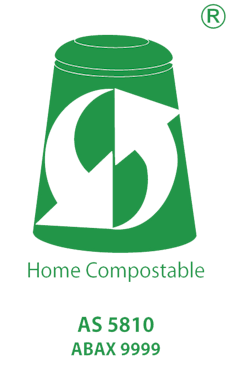
But most certified compostable plastics are only for industrial composts, which reach very high temperatures. This means they’re unlikely to break down sufficiently in home composts. Even those certified as “home compostable” are assessed under perfect lab conditions, which aren’t easily achieved in the backyard.
And while certified compostable plastics are increasing, the number of industrial composting facilities that actually accept them isn’t yet keeping up.
Nor are collection systems to get your plastics to these facilities. The vast majority of kerbside organics recycling bins don’t currently accept compostable plastics and other packaging. This means placing compostable plastics in these bins is considered contamination.
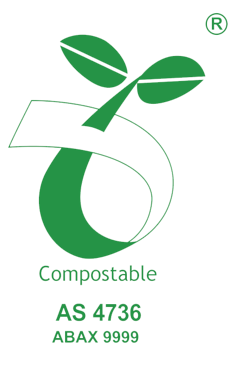
Even if you can get your certified compostable plastics to an appropriate facility, composting plastics actually reduces their economic value as they can no longer be used in packaging and products. Instead, they’re only valuable for returning nutrients to soil and, potentially, capturing a fraction of the energy used to produce them.
Finally, if you don’t have an appropriate collection system and your compostable plastic ends up in landfill, that might actually be worse than traditional plastic. Compostable plastics could release methane — a much more potent greenhouse gas than carbon dioxide — in landfill, in the same way food waste does.
So, you should only consider compostable plastics when you have a facility that will take them, and a way to get them there.
And while the National Plastics Plan and National Packaging Targets are aiming for at least 70% of plastics to be recovered by 2025 (including through composting), nothing yet has been said about how collection systems will be supported to achieve this.
Read more: Why compostable plastics may be no better for the environment
Is Recycling Helpful?
Only an estimated 9% of plastics worldwide (and 18% in Australia) are actually recycled. The majority ends up in landfill, and can leak into our oceans and natural environments.
In Australia, systems for recycling the most common types of plastic packaging are well established and in many cases operate adequately. However, there are still major issues.

For example, many plastic items can’t be recycled in our kerbside bins (including soft and flexible plastics such as bags and cling films, and small items like bottle lids, plastic cutlery and straws). Placing these items in your kerbside recycling bin can contaminate other recycling and even damage sorting machines.
Read more: Think all your plastic is being recycled? New research shows it can end up in the ocean
What’s more, much of the plastic collected for recycling doesn’t have high value “end markets”. Only two types of plastic — PET (think water or soft drink bottles and some detergent containers) and HDPE (milk bottles, shampoo/conditioner/detergent containers) — are easily turned back into new plastic containers.
The rest end up in a stream called “mixed plastics”, much of which we have traditionally exported overseas for recycling due to low demand here. The new waste export ban may help fix this in the future.
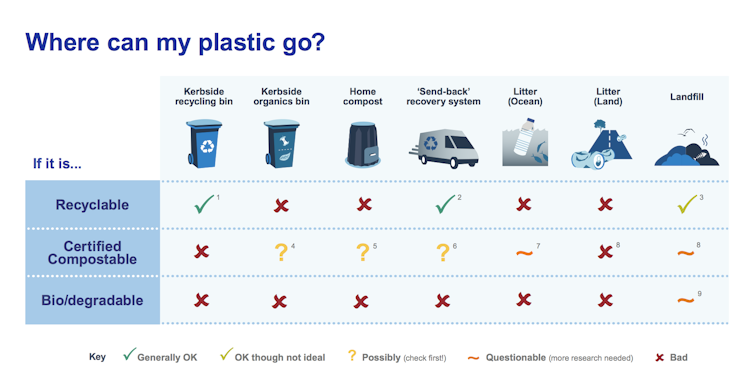
So What Do You Do About Plastic?
The obvious answer then, is to eliminate problematic plastic altogether, as the National Plastics Plan is attempting to do, and replace single-use plastics with reusable alternatives.
Little actions such as bringing your reusable water bottle, coffee cup and cutlery, can add up to big changes, if adequately supported by businesses and government to create a widespread culture shift. So too, could a swing away from insidious coffee capsules, cling wrap and cotton buds so many of us depend on.
Opting too, for plastic items made from recycled materials can make a big impact on the feasibility of plastic recycling.
If you do end up with plastic on your hands, take a quick glance at the graphic above, or read the University Technology Sydney’s Detailed Decision Guide to Disposing of Plastics.
Read more: How to break up with plastics (using behavioural science) ![]()
Jenni Downes, Research Fellow, BehaviourWorks Australia (Monash Sustainable Development Institute), Monash University; Kim Borg, Research Fellow at BehaviourWorks Australia, Monash Sustainable Development Institute, Monash University, and Nick Florin, Research Director, Institute for Sustainable Futures, University of Technology Sydney
This article is republished from The Conversation under a Creative Commons license. Read the original article.
New Shorebirds WingThing For Youngsters Available To Download
A Shorebirds WingThing educational brochure for kids (A5) helps children learn about shorebirds, their life and journey. The 2021 revised brochure version was published in February 2021 and is available now. You can download a file copy here.
If you would like a free print copy of this brochure, please send a self-addressed envelope with A$1.10 postage (or larger if you would like it unfolded) affixed to: BirdLife Australia, Shorebird WingThing Request, 2-05Shorebird WingThing/60 Leicester St, Carlton VIC 3053.

 Shorebird Identification Booklet
Shorebird Identification Booklet
The Migratory Shorebird Program has just released the third edition of its hugely popular Shorebird Identification Booklet. The team has thoroughly revised and updated this pocket-sized companion for all shorebird counters and interested birders, with lots of useful information on our most common shorebirds, key identification features, sighting distribution maps and short articles on some of BirdLife’s shorebird activities.
The booklet can be downloaded here in PDF file format: http://www.birdlife.org.au/documents/Shorebird_ID_Booklet_V3.pdf
Paper copies can be ordered as well, see http://www.birdlife.org.au/projects/shorebirds-2020/counter-resources for details.
Download BirdLife Australia's children’s education kit to help them learn more about our wading birdlife
Shorebirds are a group of wading birds that can be found feeding on swamps, tidal mudflats, estuaries, beaches and open country. For many people, shorebirds are just those brown birds feeding a long way out on the mud but they are actually a remarkably diverse collection of birds including stilts, sandpipers, snipe, curlews, godwits, plovers and oystercatchers. Each species is superbly adapted to suit its preferred habitat. The Red-necked Stint is as small as a sparrow, with relatively short legs and bill that it pecks food from the surface of the mud with, whereas the Eastern Curlew is over two feet long with a exceptionally long legs and a massively curved beak that it thrusts deep down into the mud to pull out crabs, worms and other creatures hidden below the surface.
Some shorebirds are fairly drab in plumage, especially when they are visiting Australia in their non-breeding season, but when they migrate to their Arctic nesting grounds, they develop a vibrant flush of bright colours to attract a mate. We have 37 types of shorebirds that annually migrate to Australia on some of the most lengthy and arduous journeys in the animal kingdom, but there are also 18 shorebirds that call Australia home all year round.
What all our shorebirds have in common—be they large or small, seasoned traveller or homebody, brightly coloured or in muted tones—is that each species needs adequate safe areas where they can successfully feed and breed.
The National Shorebird Monitoring Program is managed and supported by BirdLife Australia.
This project is supported by Glenelg Hopkins Catchment Management Authority and Hunter Local Land Services through funding from the Australian Government’s National Landcare Program. Funding from Helen Macpherson Smith Trust and Port Phillip Bay Fund is acknowledged.
The National Shorebird Monitoring Program is made possible with the help of over 1,600 volunteers working in coastal and inland habitats all over Australia.
The National Shorebird Monitoring program (started as the Shorebirds 2020 project initiated to re-invigorate monitoring around Australia) is raising awareness of how incredible shorebirds are, and actively engaging the community to participate in gathering information needed to conserve shorebirds.
In the short term, the destruction of tidal ecosystems will need to be stopped, and our program is designed to strengthen the case for protecting these important habitats.
In the long term, there will be a need to mitigate against the likely effects of climate change on a species that travels across the entire range of latitudes where impacts are likely.
The identification and protection of critical areas for shorebirds will need to continue in order to guard against the potential threats associated with habitats in close proximity to nearly half the human population.
Here in Australia, the place where these birds grow up and spend most of their lives, continued monitoring is necessary to inform the best management practice to maintain shorebird populations.
BirdLife Australia believe that we can help secure a brighter future for these remarkable birds by educating stakeholders, gathering information on how and why shorebird populations are changing, and working to grow the community of people who care about shorebirds.
To find out more visit: http://www.birdlife.org.au/projects/shorebirds-2020/shorebirds-2020-program
Aussie Bread Tags Collection Points

March Indexation Delivers Increased Payments
$1.3 Billion Boost For Australian Households
New Study Links Protein Causing Alzheimer's Disease With Common Sight Loss
It's not just doorways that make us forget what we came for in the next room

Imagine you’re in the middle of watching a riveting episode of your favourite TV show. You decide the situation calls for popcorn, so you get up and head to the kitchen.
But when you arrive in the kitchen you suddenly stop and think to yourself:
Why did I come in here?
Perplexed, you walk back into the living room. As soon as you sit down, you remember you wanted to make popcorn. You go back into the kitchen, this time with a newfound determination.
The Doorway Effect
We’ve all experienced a situation like this. Although these lapses in memory might seem entirely random, some researchers have identified the culprit as the actual doorways.
Many studies have investigated how memory might be affected by passing through doorways.
Astoundingly, these studies show doorways cause forgetting, and this effect is so consistent it has come to be known as the “doorway effect”.
Read more: Curious Kids: why do I sometimes forget what I was just going to say?
When we move from one room to another, the doorway represents the boundary between one context (such as the living room) and another (the kitchen). We use boundaries to help segment our experience into separate events, so we can more easily remember them later.
These “event boundaries” also help define what might be important in one situation from what might be important in another. Hence, when a new event begins, we essentially flush out the information from the previous event because it might not be relevant anymore.
In other words, our desire for popcorn is connected with the event in the living room (the TV show) and that connection is disrupted once we arrive in the kitchen.
Let’s Put This To The Test
If the doorway effect is so powerful, why are these memory lapses at home actually quite rare? We decided to look into this effect more closely.
We had 29 people wear a virtual reality headset and move through different rooms in a 3D virtual environment (see image below).

The task was to memorise objects (a yellow cross, a blue cone, and so on) on tables within each room and then move from one table to the next. Crucially, sometimes the next table was in the same room, and at other times people had to move through an automatic sliding door into another room.
To our surprise, we found the doorways had no effect on memory. That is, people very rarely forgot the objects, whether they went through a doorway or not.
Let’s Make The Memory Test Harder
We decided to repeat the experiment, but this time we had 45 people perform a difficult counting task at the same time, to increase the pressure on the task.
Under these more difficult conditions, this time we confirmed the doorway effect. That is, passing through doorways impaired people’s memory of the various objects. Specifically, people were more likely to mistake a similar object for the one they were supposed to have memorised.
Essentially, the counting task overloaded people’s memory, making it more susceptible to the interference caused by the doorway.
This finding more closely resembles everyday experience, where we most often forget what we came into a room to do when we are distracted and thinking about something else.
Is The Doorway To Blame?
Why is our result so different to the powerful doorway effect reported by previous studies?
We believe it’s because we designed the rooms to be visually identical. There was no change in context, and there was no surprise by how the next room looked. This means it’s not so much the doorway by itself that causes forgetting, but more about the change of environment.
Imagine you are in a shopping centre. Taking the lift from the car park to a retail level should lead to more forgetting than taking the lift simply to move between two retail levels.
So how might we improve our ability to remember what we’re doing as we move about from room to room?
Our results suggest the more we multitask, the more likely our memory will be flushed out by doorways.
We can only hold a certain amount of information in mind at a time. When we’re distracted by thoughts about other things, our working memory can more easily become overloaded.
Also, it’s not only doorways. Our brain engages in “event segmentation” in all facets of life, whether it’s in physical space or in a more abstract sense.
So What Can We Do?
In most cases, our tendency to segment our lives into distinct events is actually advantageous. Our information capacity is limited so we can’t remember too much information in one go.
Read more: Here's why memories come flooding back when you visit places from your past
Thus, it’s more efficient for us only to retrieve information about the current situation, rather than remembering all the information from everything we’ve recently experienced.
But if we want to escape the enchantment of the doorway, our best chance is to keep a focused mind. So keep thinking about popcorn the next time you want to get some to eat while watching your favourite TV show.![]()
Oliver Baumann, Assistant Professor, School of Psychology, Bond University and Jessica McFadyen, Research fellow, UCL
This article is republished from The Conversation under a Creative Commons license. Read the original article.
Master Luthier Visitor
Antonio Stradivari
Antonio's parents were Alessandro Stradivari, son of Giulio Cesare Stradivari, and Anna Moroni, daughter of Leonardo Moroni. They married on 30 August 1622, and had at least three children between 1623 and 1628: Giuseppe Giulia Cesare, Carlo Felice, and Giovanni Battista. The baptismal records of the parish of S. Prospero then stop, and it is unknown whether they had any children from 1628 to 1644. This gap in the records may be due to the family leaving Cremona in response to war, famine, and plague in the city from 1628 to 1630, or the records may have been lost due to clerical reforms imposed by Joseph II of Austria in 1788. The latter explanation is supported by the word Cremonensis (of Cremona) on many of Stradivari's labels, which scholars/historians state suggests that he was born in the city instead of merely moving back there to work. Antonio was born in 1644, a fact deducible from later violins. However, there are no records or information available on his early childhood, and the first evidence of his presence in Cremona is the label of his oldest surviving violin from 1666.
Some researchers believe there is a closer educational association between Antonio Stradivari and Francesco Rugeri than has previously been recognised. Despite the long-held belief that Antonio Stradivari was the pupil of Nicolò Amati, there are important discrepancies between their work. Some researchers believe early instruments by Stradivari bear a stronger resemblance to Francesco Rugeri's work than Amati's. Additionally, the utilisation of a small dorsal pin or small hole, invariably used not just by Nicolò Amati but all of his recognized pupils—with the exception of Antonio Stradivari, adds further evidence that Stradivari may have learnt his craft apart from Amati. This pin or hole was fundamental in the graduation of the thickness of the plates and was obviously a technique passed on through generations of pupils of the Amati. This dorsal pin is also not found in any of the instruments of the Rugeri family, suggesting Antonio Stradivari may have actually learnt his craft from Francesco Rugeri, although both were influenced by Amati.
Stradivari purchased a house now known as No. 1 Piazza Roma (formerly No. 2 Piazza San Domenico) around 1680 for the sum of 7000 lire, 2000 of which he paid at the time of the purchase. The house was paid for in full by 1684. The residence was just doors away from those of several other violin-making families of Cremona, including the Amatis and Guarneris. Stradivari probably worked in the loft or attic, and stayed in this house for the rest of his life.
.jpg?timestamp=1615613168248)
A romanticised print of Antonio Stradivari examining an instrument - Unknown author - per Oberndorfer, Anne Faulkner (1921). What we hear in music. Camden, NJ: Educational dept
Stradivari's early career is marked by wide experimentation, and his instruments during this period are generally considered of a lesser quality than his later work.[41] However, the precision with which he carved the heads and inserted the purfling quickly marked him as one of the most dextrous craftsmen in the world, a prime example of this being the 1690 "Tuscan" violin. Pre-1690 instruments are sometimes termed "Amatisé" but this is not completely accurate; it is largely because Stradivari created many more instruments later on that people try to connect his early work with Amati's style.
In the early 1690s, Stradivari made a pronounced departure from this earlier style of instrument-making, changing two key elements of his instruments. First, he began to make violins with a larger pattern than previous instruments; these larger violins usually are known as "Long Strads". He also switched to using a darker, richer varnish, as opposed to a yellower varnish similar to that used by Amati. He continued to use this pattern until 1698, with few exceptions. After 1698, he abandoned the Long Strad model and returned to a slightly shorter model, which he used until his death. The period from 1700-1725 is often termed the "golden period" of his production. Instruments made during this time are usually considered of a higher quality than his earlier instruments. Late-period instruments made from the late 1720s until his death in 1737 show signs of Stradivari's advancing age. These late instruments may be a bit less beautiful than the Golden Period instruments, but many nonetheless possess a fine tone. Heavier and looser craftmanship of the late Stradivari output can be seen in the 1734 'Habeneck'.
Stradivari's instruments are regarded as amongst the finest bowed stringed instruments ever created, are highly prized, and are still played by professionals today. Only one other maker, Giuseppe Guarneri del Gesù, commands a similar respect among violinists.
Some violinists and cellists use Stradivari instruments in their work. Cellos: Yo-Yo Ma uses the Davidov Stradivarius, Julian Lloyd Webber employs the Barjansky Stradivarius, and, until his death in 2007, Mstislav Rostropovich played on the Duport Stradivarius. Violins; The Soil of 1714 is owned by virtuoso Itzhak Perlman. The Countess Polignac is currently played by Gil Shaham. The Vienna Philharmonic uses several Stradivari instruments that were purchased by Austria's central bank Oesterreichische Nationalbank and other sponsors: Chaconne, 1725; ex-Hämmerle, 1709; ex-Smith-Quersin, 1714; ex-Arnold Rosé, ex-Viotti, 1718; and ex-Halphen, 1727. Viktoria Mullova owns and plays the Jules Falk. Joshua Bell owns and plays the Gibson ex-Huberman.
The London sales of The Mendelssohn at £902,000 ($1,776,940) in 1990 and The Kreutzer for £947,500 in 1998 constitute two top-selling Stradivari. A record price paid at a public auction for a Stradivari was $2,032,000 for the Lady Tennant at Christie's in New York, April 2005. On 16 May 2006, Christie's auctioned Stradivari's 1707 Hammer for a new record of US$3,544,000. On 2 April 2007, Christie's sold a Stradivari violin, the 1729 Solomon, Ex-Lambert, for more than $2.7 million to an anonymous bidder in the auction house's fine musical instruments sale. Its price, US$2,728,000 including Christie's commission, far outdid its estimated value: $1 million to $1.5 million. On 14 October 2010, a 1697 Stradivari violin known as "The Molitor" was sold online by Tarisio Auctions for a world-record price of $3,600,000 to violinist Anne Akiko Meyers: at the time its price was the highest for any musical instrument sold at auction. On 21 June 2011, the Lady Blunt Stradivarius, a 1721 violin, was auctioned by Tarisio to an anonymous bidder for almost £10 million, with all proceeds going to help the victims of the 2011 Tōhoku earthquake and tsunami. This was over four times the previous auction record for a Stradivari violin.
The collection of the New Jersey Symphony Orchestra had the largest number of Stradivari in its string section, purchased in 2003 from the collection of Herbert R. Axelrod, until it decided to sell them in 2007. A collection assembled by Rodman Wanamaker in the 1920s contained as many as 65 stringed instruments by such masters as Stradivari, Gofriller, Baptiste and Giuseppe Guarneri. Included was The Swan, the last violin made by Stradivari, and soloist instrument of the great Cuban 19th-century virtuoso Joseph White.
The collection, known as The Cappella, was used in concerts with the Philadelphia Orchestra and Leopold Stokowski before being dispersed after Wanamaker's death.
The Vienna Philharmonic uses four violins and one cello. The Metropolitan Museum of Art has three Stradivari violins dated 1693, 1694 and 1717. The National Music Museum, in Vermillion, South Dakota, has in its collection one of the known Stradivari guitars, one of eleven known violas da gamba, later modified into a cello form, one of two known choral mandolins, and one of six Stradivari violins that still retain their original neck. In the interests of conservation, the Messiah Stradivarius violin—on display in the Ashmolean Museum in Oxford, England—has not been played at all in recent years.
The Sabionari is one of the known five guitars made by Stradivari that still exist; the neck of a sixth guitar, dated 1675, has also survived and is currently exhibited with the other Stradivarian relics in Cremona. Beside the Sabionari, another two guitars were made in the 17th century: the Giustiniani, 1681, and the Hill, dated 1688.
The Sabionari is the only one that can still be played though.
A letter written in 1854 by the owner of the time, Filippo Benetti, a bookseller from Ferrara to a new buyer, the landowner Vincenzo Tioli from Bologna, informs that the guitar had been previously sold by the Stradivari family descendants to Giovanni Sabionari (from whom the guitar takes its name), the year of the sale is not provided.
In 1888 the Sabionari guitar was presented by a new owner F. Donati to the International Music Exhibition in Bologna. In 1934 a dealer in Bologna (Italy) sent a letter and some photos to the Stradivarius Museum in Cremona to sell the guitar but they couldn't find an agreement. In 1948 the Sabionari guitar was sold to the Domenichini family, Italy.
This is how it sounds.
Antonio Stradivari 1679 'Sabionari' Guitar; Krishnasol Jiménez Plays Bartolotti
Angelo Michele Bartolotti - Suite G minor - Sarabande (Published in Rome in 1655 and dedicated to Christina, Queen of Sweden)
Recorded in 2015 in Cremona - Museo del Violino - Auditorium Giovanni Arvedi
- The Sabionari Stradivarius guitar at: http://www.sabionari.com/
- Wikipedia
- Friends of Stradivarius
Funding Boost For Councils For Youth Week 2021

NSW Youth Advisory Council 2021 Applications Now Open
- Question: What do you think are the important issues affecting children and young people in NSW? Please explain why you think these issues are important. (As a guide, your answers should be no more than 250 words.)
- Question: What life experiences have you had which would assist you in contributing to the Council’s work?
- Question: Details of any current or past voluntary or community activities you have been involved in.
- We'll ask a few questions about you and your background.
Beauty In The Genes: Mother And Daughter Open Beauty Salon
 A dynamic mother and daughter duo has launched a joint beauty salon in Yamba, featuring Australian and local organic products.
A dynamic mother and daughter duo has launched a joint beauty salon in Yamba, featuring Australian and local organic products.
In early 2020, Daisy Lloyd was considering her career pathway options after a gap year.
Her mother, Natalie Le Breton, saw a Certificate III in Beauty Services offered at TAFE NSW Maclean. With a shared interest in beauty, they decided to enrol and study the course together.
While studying, the duo recognised a business opportunity in Yamba and started making plans to open their own beauty salon. Ngara Beauty Yamba officially launched in December 2020.
"As a mature-aged student and a school leaver, our TAFE NSW teacher made studying less intimidating and really guided us through the course," said Ms Le Breton.
"Daisy has already completed a lash extension short course at TAFE NSW Grafton to expand our services."
"We have always been really close, and we have a great understanding of each other's strengths and weaknesses. Since opening, Daisy has taken over our social media, and I've been banned from posting."
TAFE NSW Teacher of Beauty Kassie Austen says Beauty services is a thriving industry bouncing back quickly post Covid-19.
"Our students finish their qualifications with the skills to successfully start their own businesses. We see graduates opening salons, as well as offering home services or renting salon space while they establish their client base," Ms Austin said.
“Natalie and Daisy are a wonderful example of the opportunities available in the beauty industry right now, regardless of where you are in your career journey."
According to the Australian Industry and Skills Committee, strong growth is expected in the beauty industry with an increase of 20% in beauty therapists by 2024, despite a 50% reduction in beauty therapists in 2020].
For more information on Beauty Services, visit www.tafensw.edu.au or phone 131 601.
Express Yourself Exhibition 2021
The talent and creativity of more than 40 HSC Visual Art students on the Northern Beaches will be on display for the annual Express Yourself exhibition at the Manly Art Gallery & Museum (MAG&M) from February 19th until March 28th 2021.
The winners of the $3,000 Manly Art Gallery & Museum Society Youth Art Award and $5,000 Theo Batten Bequest Youth Art Award will be announced on Friday 19th of February. These two awards are granted annually to students featured in the exhibition.
Artist statements will be displayed alongside the artworks describing the inspirations and influences that informed the works and the students’ creative journeys.
Visitors are encouraged to vote for their favourite artwork in the KALOF People’s Choice Award which is announced at the end of the exhibition period.
Express Yourself is also part of Art Month Sydney, March 2021.
Exhibition: 19 February - Sunday 28 March 2021, 10am - 4pm daily (excluding Mondays)
Teachers' preview: Friday 19 February, 5 - 6pm. Bookings essential via Council’s website
Art Walk and Talk: Saturday 27 February, 3 – 4pm: Artists walk through the exhibition and discuss their works with the curator. Bookings essential via Council’s website.
New evidence shows half of Australians have ditched social media at some point, but millennials lag behind
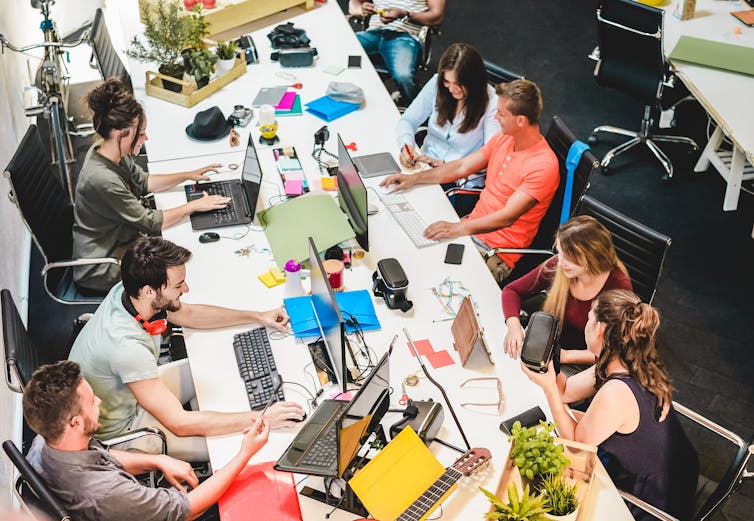
A recent nationally representative survey has shown Australians are willing and able to pull the plug on social media.
But it turns out the generation you were born in, as well as your level of education, will likely have a bearing on whether you do. This is important, as recent events have set the precedent for tech giants to pull or change content at any time.
Short-lived as it was, Facebook’s removal of Australian news raised interesting questions about our dependence on social media and whether we can do without it.
Read more: Google is leading a vast, covert human experiment. You may be one of the guinea pigs
Growing Frustration With Platforms
Facebook’s actions (coupled with Google’s earlier threat to pull its Search function from Australia) prompted widespread criticism.
Twitter users got #deletefacebook trending, while news columns called on Australians to consider distancing themselves from the platform. But it’s difficult to know exactly how many did.
The Australian Survey of Social Attitudes (AUSSA) is one of few studies uniquely placed to provide a balanced view on Australians’ social media use.
The randomised, nationally representative sample of the Australian population captures those who have never used social media, those who have curbed their use and those who have never stopped or reduced their use.
Results from the 2019–20 survey show many Australians have either cut back on social media, or quit it altogether. Half the respondents had reduced their use at some point.
Reasons For Disconnecting
People disconnect from social media for various reasons. These include concerns over privacy, an “always on” digital culture, pressure from being on display to the public and pressure from comparing oneself to others.
Others hold practical concerns such as wasting time, being too busy to use social media, losing interest or being bored. The majority (52%) of AUSSA respondents cited “boredom” and “time wasting” as the main reasons for limiting social media use.
Considering this, Facebook’s threat to become news-free may have constituted self-sabotage; it would have made the platform a blander, less informative and more disposable space.
Read more: If Facebook really pulls news from its Australian sites, we'll have a much less compelling product
Australians registered other concerns too, but in lower numbers. For instance, 18% cited frustration with online personas (such as excessive social comparisons and inauthenticity) as their main reason for disconnecting, while 15% cited privacy concerns.
Meanwhile, 14% of respondents had never used social media and 36% continued to use it consistently.
Breakdown By Education
Past research has raised concerns over “internet addiction”, which refers to becoming so embedded in social media it becomes difficult to exit.
And the AUSSA survey reveals some of us seem more likely (and possibly more able) than others to disconnect from digital life.
Education was an important predictor of social media use and disconnection. Of those who hadn’t completed high school, 45% had reduced their social media use.
This rose to 51% among those with a high-school or post-school certificate — and to 56% among degree holders.
The link between higher education and social media use speaks to a certain “privilege of disconnection”, whereby the choice to disengage is easier for those with certain resources.
For example, when tertiary-educated people give up social media, they may be better placed to replace the networks and information lost with other sources of connection and capital.
Generational Gaps
There were also notable differences in social media use between generations, although usage generally increased as generations became younger.
Of the Silent Generation (currently 76-93 years old), 40% had never used social media. This dropped to 0% among Gen Z (9-24 years old).
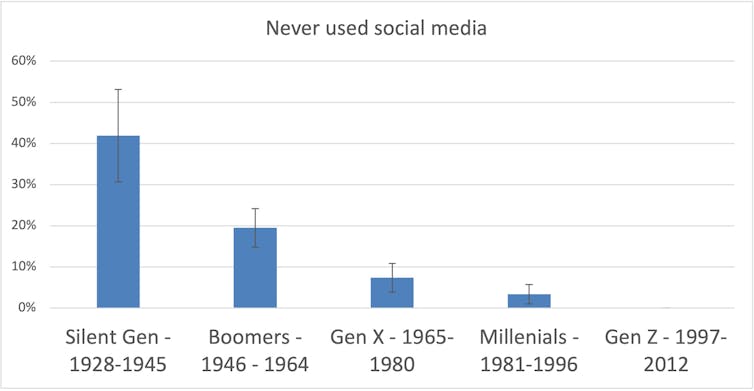
At 62%, Gen X (41-56 years old) led the way in social media reduction and disconnection. They were significantly more likely to have used and disconnected than baby boomers (57-75 years old).
But the rates of reduction and disconnection among millennials (25-40 years old) decreased, before increasing again for Gen Z. Millennials were also much more likely than Gen X to have never reduced their social media use at any point.
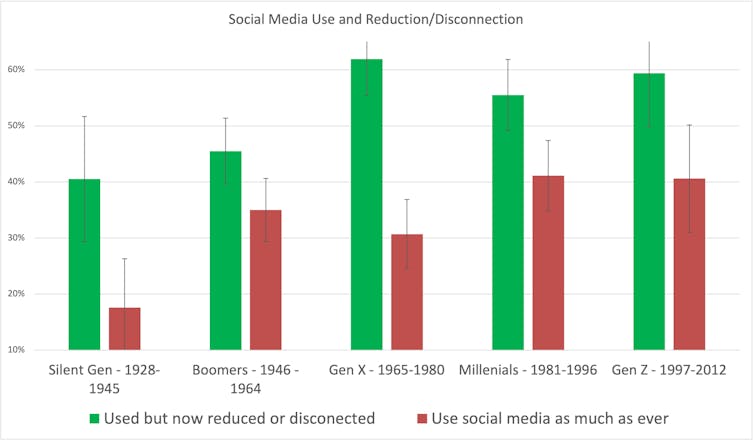
The relatively lower disconnection rate and higher usage rate among millennials is perhaps concerning.
This group may simply not have found a good reason to disconnect. However, since millennials were raised with social media strongly integrated into their teenage and adult lives, it may harder for them to kick the habit when needed.
The slight increase in disconnection among Gen Z is telling here, as it suggests the generation to follow may have developed a little more critical awareness of the downsides of making social media omnipresent in one’s life.

Managing A Challenging Relationship
The survey findings suggest social media use is indeed ubiquitous among young people.
But they also suggest claims of a widespread rise in “internet addiction” are excessive, since the majority of respondents from Gen X onward had either reduced or halted their social media use.
This is good news. Tech platforms at times have shown an ethically questionable willingness to sacrifice our privacy and agency for personal gain, with both Facebook and Google guilty of covertly experimenting on users in the past.
These survey findings suggest we have some agency of our own. Tech giants can’t rely on user loyalty, or inertia and certainly not addiction.
Users may happily switch platforms — or switch off altogether — if they continue to be treated like bargaining chips in business deals. Big tech, take note.![]()
Roger Patulny, Associate Professor of Sociology, University of Wollongong
This article is republished from The Conversation under a Creative Commons license. Read the original article.
Friday essay: is this the end of translation?
Mridula Nath Chakraborty, Monash UniversityIn 399 CE, Faxian — a monk in China’s Jin Dynasty — went on a pilgrimage to the Indian subcontinent to collect Buddhist scriptures. Returning after 13 years, he spent the rest of his life translating those texts, profoundly altering Chinese worldviews and changing the face of Asian and world history.

After Faxian, hundreds of Chinese monks made similar journeys, leading not only to the spread of Buddhism along the Nirvana Route, but also opening up roads to medicine men, merchants and missionaries.
Along with the two other great translation movements — Graeco-Arabic in the Umayyad and Abbasid periods (2nd-4th and 8th-10th century) and Indo-Persian (13th-19th centuries) — these events were major attempts to translate knowledge across linguistic boundaries in world history.
Transcending barriers of language and space, acts of translation touched and transformed every aspect of life: from arts and crafts, to beliefs and customs, to society and politics.
Going by the latest casualty in the heated — but necessary — debates around representation in our creative and cultural arenas, none of this would be possible today.
Last month, Marieke Lucas Rijneveld, the youngest writer ever to win the International Booker Prize for The Discomfort of Evening (with translator Michele Hutchison), was chosen to translate 22-year-old American poet laureate Amanda Gorman’s forthcoming collection, The Hill We Climb, for Dutch publisher Meulenhoff.
Gorman selected Rijneveld herself. But amid backlash that a white prose writer was chosen to translate the work of an unapologetically Black, spoken word poet, Rijneveld resigned saying,
I understand the people who feel hurt by Meulenhoff’s choice to ask me […] I had happily devoted myself to translating Amanda’s work, seeing it as the greatest task to keep her strength, tone and style. However, I realise that I am in a position to think and feel that way, where many are not.
This week, meanwhile, the poem’s Catalan translator Victor Obiols told AFP he had been removed from the job by Barcelona publisher Univers.
They did not question my abilities, but they were looking for a different profile, which had to be a woman, young, activist and preferably black.
We live in a world rife with controversies around cultural appropriation and identity politics. The power differentials created by the twin forces of colonialism and capitalism are being interrogated in every realm today.
It was only a matter of time before these burning issues ignited the art of translation.
Usually invisible and taken-for-granted, acts of translation take place around us all the time. But in the field of literary translation, questions of authorial voice and speaking position matter.
Marginalised creative practitioners and their growing audiences assume importance in a global publishing regime controlled by a dominant minority wielding majority power over issues of representation.
So it is fitting that some have drawn attention to the myriad spoken word artists eminently qualified to undertake translation in the Netherlands. And Dutch agents, publishers, editors, translators and reviewers could certainly broaden their horizons and embrace diversity.
Nevertheless, if humans only translated the familiar, how would we ever have an inkling of the astonishing world out there that is not familiar?
The task of literary translation entails grappling with profound difference, in terms of language, imagination, context, traditions, worldviews.
None of this would enter our quotidian consciousness but for the translators who step into uncharted waters because they have fallen in love with another tongue, another world.
Translation Is Resistance
Translators ferry across the meaning, materiality, metaphysics and all the magic that may be unknown in the mediums and conventions of their own tongue. The pull of the strange, the foreign, and the alien are necessary for acts of translation.
It is this essential element of unknowingness that animates the translator’s curiosity and challenges her intellectual mettle and ethical responsibility. Even when translators hail from — or belong to — the same culture as the original author, the art relies on the oppositional traction of difference.
Through opposition and abrasion, a creative translation allows for new meaning and nuance to emerge.
Noaki Sakai, a Japanese historian and translator at Cornell University, writes about the historical complexity of this process. The practices of translation, he says, are “always complicit with the building, transforming and disrupting of power differences.”
Translation Is Domination
Translation has, however, been a tool for domination in colonisation. La Malinche, for instance, acted as an intermediary and interpreter for the conquistador, Hernán Cortés, in the 16th century Spanish conquest of the Aztec Empire.

Patyegarang was Australia’s first teacher of Aboriginal language, to early colonist, William Dawes, and crucial for the survival of the Gamaraigal language in Eora country. At 15, and as an initiated woman, she was Dawes’ intellectual equal, learning English from him and negotiating a relationship of mutual translation while holding on to her own cultural legacy.
In each of these cases, European imperialists learnt how to survive the lands they were conquering through the processes of translation. Moreover, they used the same languages to fabricate the story of their own superior Western civilisation, at the cost of Indigenous cultures.
As translation theorist Tejaswini Niranjana explains, translation:
shapes, and takes shape within, the asymmetrical relations of power that operate under colonialism.
Translation is not a neutral activity. It functions in a complex set of socio-political relations, where parties have vested interests in the production, dissemination and reception of stories and texts.
Academics Sabine Fenton and Paul Moon have written about the deliberate mis-translation of the Treaty of Waitangi, a strategic example of colonial omissions and selections that achieved “the cession of Maori sovereignty to the Crown.”
One egregious interpolation was the replacement of the word mana (sovereignty) with kawanatanga (government), which misled and induced many Maori chiefs to sign the treaty.
Read more: Explainer: the significance of the Treaty of Waitangi
In situations of conflict and war — and the displacements that result from them — translation again becomes a weapon privileging the powerful, as seen in the impenetrable bureaucratic paperwork, in the dominant language, governing asylum and refugee seeker decisions.
In this charged context, the case of Gorman and Rijneveld becomes a lightning rod for addressing historical disempowerment and injustices.
Translation Is Diplomatic
In the absence of a level playing field for writers to have their voices heard in the global publishing market, there does need to be historical awareness and post-colonial sensitivity.
To Rijneveld’s credit, this sensitivity has been demonstrated. After stepping down as Gorman’s translator, they composed a poem:
never lost that resistance, that primal jostling with sorrow and joy,
or given in to pulpit preaching, to the Word that says what is
right or wrong, never been too lazy to stand up, to face
up to all the bullies and fight pigeonholing with your fists
raised, against those riots of not-knowing inside your head
Still, while representation is the moral imperative of the 21st century, it is my modest proposal that in the realm of literary translation, the pull of the unknown and the unfamiliar is one of the most important truisms: Rijneveld’s “riots of not-knowing.”
Already the world is losing a language every fortnight; 7000 languages are expected to be extinct by the end of this century. Yet it has often been argued that linguistic diversity is an indicator of genetic diversity, the latter being critical to the survival of the species.
If humans only translate what is known within their own four walls, or what is familiar to them within the boundaries of their own imaginations, something essential is lost both to translation — and to the profligate tongues that proliferate our humanity.
Translation Is Activism
We do not live in a post-racial world. We do not live in a borderless world — as brought to the fore powerfully by the COVID-19 pandemic. For translators in transnational times, it is of the essence that we break down ethno-linguistic borders, accepting the challenge of the confronting.
In my own work, I have collaborated on translations of Aboriginal & Torres Strait Islander, and tribal & Dalit Indian poets. This has necessarily involved the hard work of understanding historical incommensurabilities.
Yes, structural inequalities mount by the day in the face of capitalism, which is a faithful handmaiden to the ongoing machinations of colonialism. Translators do not live in a vacuum. We are not immune to the forces of structural racism.
But why is it that Rijneveld had to renounce the commission as an individual? Why does this recent story become about individual actions, rather than the entrenched patterns of operation of publishing houses like Meulenhoff?
To achieve equity, transformation must be structural — it cannot fall on the shoulders of one translator alone, making them a fall guy for the business of books as usual.
The directors and CEOs of dominant global (read: Western) publishing companies are predominantly white. Which begs the familiar question: what if editorial boards reflected the multiplicity of society across the axes of class, gender, race, sexuality and ability?
Imagine the scenario if even one of Australia’s mainstream publishing houses was led by a non-white head and/or board?
Read more: Diversity, the Stella Count and the whiteness of Australian publishing
It is precisely the duty of heads of publishing houses, literary and review magazines and cultural institutions, to invite a teeming world of translators to take charge of what needs to be done.

Still, a translator must attend to the demands of integrity and imagination as much as the demands of history and society. She must throw herself into the challenging task of being in another time and place, of rubbing against the grain of her own aims and assumptions.
Only in imagining such a Babelian world of difference can a truly radical set of possibilities become alive.
This is not to argue that translators who come from similar backgrounds will not be able to engage in the task of translation in ways that wrestle with the creative resistance entailed in such a task. But the field must remain open to whoever is called to the task.
Literary translation is often a matter of happy accidents and passionate engagements. Han Kang’s The Vegetarian (2007) became a runaway success in the United Kingdom and United States in 2016, when Deborah Smith, who had been learning Korean for only six years, embarked on the task.
There have been critiques of her translation, but representation is not the issue. Part of the beauty of translation is that texts can be critiqued, and translated again and again.
Translation lore is enriched continually by examples of re-translations, such as the ten translations into English of Tolstoy’s Anna Karenina alone, or the two of Orhan Pamuk’s The Black Book.
The act and the art of translation requires the permission to transcend borders, the permission to make mistakes, and the permission to be repeated, by anyone who feels the tempestuous tug, and the clarion call, of the unfamiliar.
To rein in such liberty through categories and compartments that imprison our creativity is a disservice to the human imagination.
So let a thousand translations bloom: that would be a start and not an end to translation as we know it now.![]()
Mridula Nath Chakraborty, Monash Intercultural Lab and National Convenor of the Asian Australian Studies Research Network, Monash University
This article is republished from The Conversation under a Creative Commons license. Read the original article.
Electronic cities: between COVID and gentrification, dance music is struggling to find its groove again

Electronic music is the fifth-most-popular music genre globally. However, the COVID-19 pandemic has been devastating for the electronic music industry. Its estimated value fell from US$7.3 billion in 2019 to US$3.3 billion in 2020.
Hundreds of electronic festivals around the world have been cancelled. Some events have gone underground. In one case, more than 1,200 people were charged over an illegal rave party in Brittany that violated France’s COVID restrictions.
Electronic dance music uses specific spaces in a city, so it’s heavily affected by both cultural and planning policies. Our new book, Electronic Cities, studies these scenes. The contributors focus on 18 cities across the world as case studies in the development of electronic music.
The world of DJs has been studied before, but not the impacts of city policies on such a global scale. The book shows electronic music is not well integrated in cultural policies and gets little support. Music city policies often do not include this music genre.
Live venues are often not well protected by planning frameworks. This puts underground scenes that rely on small clubs at risk.
In Australia, we have seen some positive strategies, such as Agent of Change in Victoria, to protect inner-city live venues. Overall, though, electronic music is not well integrated in city policies.
The Rise Of A Global Phenomenon
Electronic music has grown from its origins in composers’ experimentation in the 1950s to encompass as many as 153 different genres. These range from commercial dance music and film soundtracks to niche/underground electronic music.
Broadly speaking, we can make a distinction between electronic dance music (EDM), also known as club music and made for dancing, and the more downtempo, conceptual intelligent dance music (IDM) made for listening at home.
Underground styles like acid techno are created by DJs, rather than musicians/producers, and are connected to specific clubs and audiences.
Australian dance music has been driven by an attitude of DIY self-reliance. Local producers such as Flume, Alison Wonderland, Will Sparks and Nervo have had international success.
All these different styles are sometimes grouped under the label of “electronic dance music culture”.
What Role Do Cities Have?
The first hubs for electronic music were in the US (Chicago and Detroit) and Germany (Dusseldorf and Berlin). Today, the culture has a global spread. Our book Electronic Cities analyses emerging electronic dance music cultures in places like Shenzhen in China, Tehran in Iran and Accra in Ghana.

Cities have used the music as a tool for city branding, to promote international tourism and to develop nightlife economies. Techno Week in Detroit, for instance, is a major drawcard for the city. In Cluj-Napoca, Romania, the Untold EDM Festival has been central to a strategy to attract tourists to this rural area.
Although some governments have embraced the industry, it has also suffered from official neglect. In large cities, small underground clubs, such as the former Club 414 in Brixton, are constantly under threat from redevelopment. These clubs have unique historic and cultural value but are not well protected by planning regulations.

What Next?
Musician and record producer Mark Reeder lives in Berlin, a world centre for clubbing. He has seen the disruptions caused by the pandemic unfold. In an interview for Electronic Cities, he said:
This is the turning point that I thought would eventually happen. After 30 years of techno, it was on the brink. I believed something new was on the horizon. Obviously, I didn’t think it would be exactly like this.
Paul Curtis, the manager of Australian band Regurgitator, which straddles punk rock and electronica, had a similar vision:
We’d already been thinking for the last bunch of years - how the hell do we continue to do what we do in a world that we have to change?
The band had been operating for some time as a kind of small-scale economy, with sustainability as a focus. The collapse of venues in the wake of COVID forced some of their plans to change, but they started to rethink options.
Curtis was puzzled by the attitude of some music business colleagues:
They were saying, ‘As soon as this is over, and we get back to normal’, and I’m thinking, well that’s just delusion.
Curtis used the pandemic quiet to finish a live concert film of the band. He has been distributing it through independent cinemas and music venues that have geared up for screenings.
Australia responded to the economic impacts of the pandemic by introducing the JobKeeper payment to help businesses retain staff. But many venues and most artists and arts workers were ineligible.
Artists globally had similar experiences. In Helsinki, Finland, as Giacomo Botta explains in Electronic Cities, public support during the pandemic went only to recognised electronic dance music organisations. More marginal and underground communities, often most affected by the pandemic, were ignored.
On a more positive note, Sara Ross, speaking as part of a panel at CTM Festival 2021, explained that switching to online platforms such as Twitch – usually used by gamers – might help Toronto DJs widen their audience.
Reeder reflects on Berlin and what the future might look like:
I think this situation is having a profound effect on the way people consume contemporary music and especially what we perceived as the club scene.
He notes the desperation of DJs streaming from home, and the emphasis on nostalgia – “sounds of the past becoming the sounds of the future”.![]()
Sebastien Darchen, Senior Lecturer in Planning, The University of Queensland; Damien Charrieras, Associate Professor, School of Creative Media, City University of Hong Kong, and John Willsteed, Senior lecturer, Queensland University of Technology
This article is republished from The Conversation under a Creative Commons license. Read the original article.
Experts Recreate A Mechanical Cosmos For The World's First Computer: The Antikythera Mechanism
March 12, 2021
Researchers at UCL have solved a major piece of the puzzle that makes up the ancient Greek astronomical calculator known as the Antikythera Mechanism, a hand-powered mechanical device that was used to predict astronomical events.
Known to many as the world's first analogue computer, the Antikythera Mechanism is the most complex piece of engineering to have survived from the ancient world. The 2,000-year-old device was used to predict the positions of the Sun, Moon and the planets as well as lunar and solar eclipses.
Published in Scientific Reports, the paper from the multidisciplinary UCL Antikythera Research Team reveals a new display of the ancient Greek order of the Universe (Cosmos), within a complex gearing system at the front of the Mechanism.

Lead author Professor Tony Freeth (UCL Mechanical Engineering) explained: "Ours is the first model that conforms to all the physical evidence and matches the descriptions in the scientific inscriptions engraved on the Mechanism itself.
"The Sun, Moon and planets are displayed in an impressive tour de force of ancient Greek brilliance."
The Antikythera Mechanism has generated both fascination and intense controversy since its discovery in a Roman-era shipwreck in 1901 by Greek sponge divers near the small Mediterranean island of Antikythera.
The astronomical calculator is a bronze device that consists of a complex combination of 30 surviving bronze gears used to predict astronomical events, including eclipses, phases of the moon, positions of the planets and even dates of the Olympics.
Whilst great progress has been made over the last century to understand how it worked, studies in 2005 using 3D X-rays and surface imaging enabled researchers to show how the Mechanism predicted eclipses and calculated the variable motion of the Moon.
However, until now, a full understanding of the gearing system at the front of the device has eluded the best efforts of researchers. Only about a third of the Mechanism has survived, and is split into 82 fragments -- creating a daunting challenge for the UCL team.
The biggest surviving fragment, known as Fragment A, displays features of bearings, pillars and a block. Another, known as Fragment D, features an unexplained disk, 63-tooth gear and plate.
Previous research had used X-ray data from 2005 to reveal thousands of text characters hidden inside the fragments, unread for nearly 2,000 years. Inscriptions on the back cover include a description of the cosmos display, with the planets moving on rings and indicated by marker beads. It was this display that the team worked to reconstruct.
Two critical numbers in the X-rays of the front cover, of 462 years and 442 years, accurately represent cycles of Venus and Saturn respectively. When observed from Earth, the planets' cycles sometimes reverse their motions against the stars. Experts must track these variable cycles over long time-periods in order to predict their positions.
"The classic astronomy of the first millennium BC originated in Babylon, but nothing in this astronomy suggested how the ancient Greeks found the highly accurate 462-year cycle for Venus and 442-year cycle for Saturn," explained PhD candidate and UCL Antikythera Research Team member Aris Dacanalis.
Using an ancient Greek mathematical method described by the philosopher Parmenides, the UCL team not only explained how the cycles for Venus and Saturn were derived but also managed to recover the cycles of all the other planets, where the evidence was missing.
PhD candidate and team member David Higgon explained: "After considerable struggle, we managed to match the evidence in Fragments A and D to a mechanism for Venus, which exactly models its 462-year planetary period relation, with the 63-tooth gear playing a crucial role."
Professor Freeth added: "The team then created innovative mechanisms for all of the planets that would calculate the new advanced astronomical cycles and minimise the number of gears in the whole system, so that they would fit into the tight spaces available."
"This is a key theoretical advance on how the Cosmos was constructed in the Mechanism," added co-author, Dr Adam Wojcik (UCL Mechanical Engineering). "Now we must prove its feasibility by making it with ancient techniques. A particular challenge will be the system of nested tubes that carried the astronomical outputs."
Tony Freeth, David Higgon, Aris Dacanalis, Lindsay MacDonald, Myrto Georgakopoulou, Adam Wojcik. A Model of the Cosmos in the ancient Greek Antikythera Mechanism. Scientific Reports, 2021; 11 (1) DOI: 10.1038/s41598-021-84310-w
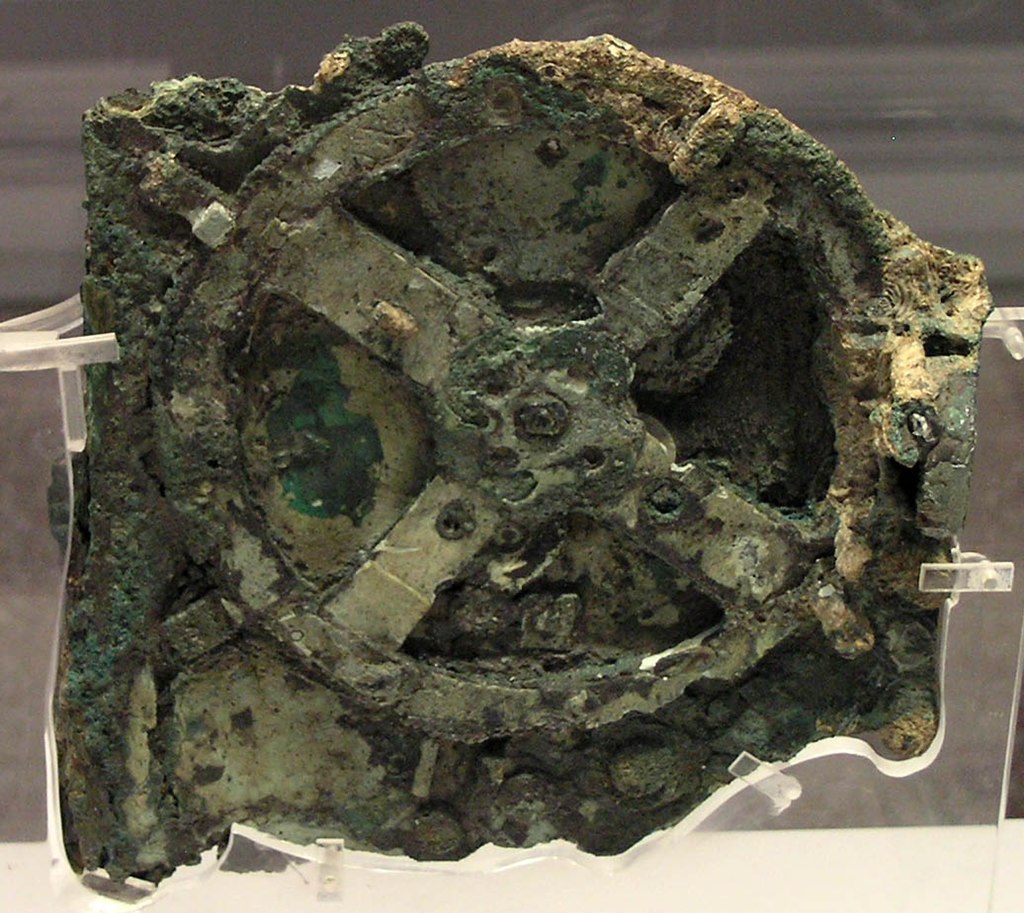
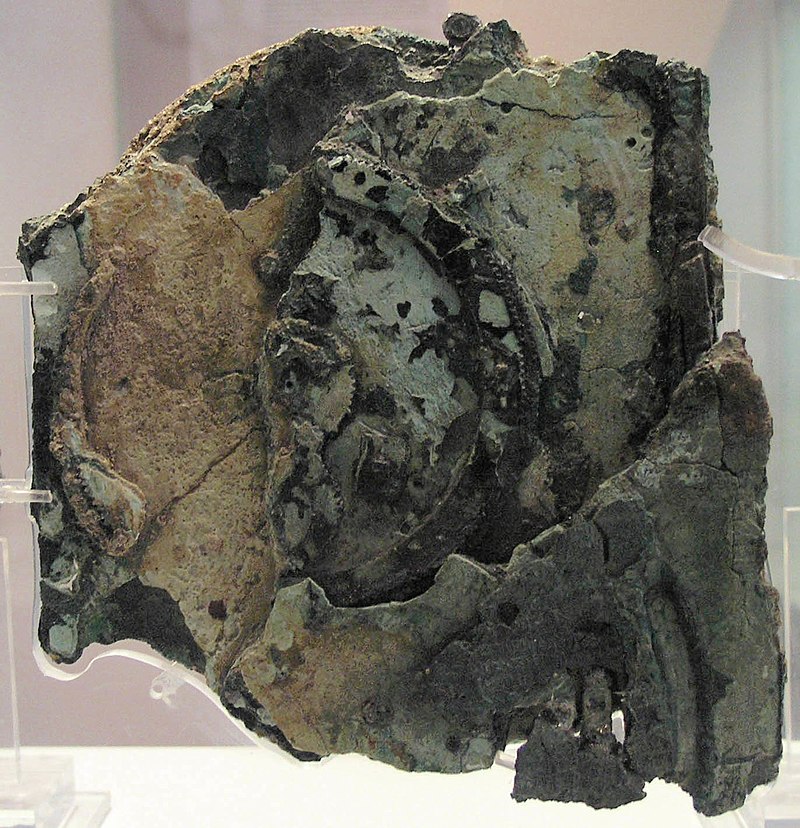
The mechanism was probably built by a mechanical engineer of the school of Posidonius in Rhodes. Cicero, who visited the island in 79/78 B.C. reported that such devices were indeed designed by the Stoic philosopher Posidonius of Apamea. The design of the Antikythera mechanism appears to follow the tradition of Archimedes' planetarium, and may be related to sundials. His modus operandi is based on the use of gears. The machine is dated around 89 B.C. and comes from the wreck found off the island of Antikythera. National Archaeological Museum, Athens, No. 15987.

Antikythera model front panel - Mogi Vicentini, 2007
5 ways to spot if someone is trying to mislead you when it comes to science

It’s not a new thing for people to try to mislead you when it comes to science. But in the age of COVID-19 — when we’re being bombarded with even more information than usual, when there’s increased uncertainty, and when we may be feeling overwhelmed and fearful — we’re perhaps even more susceptible to being deceived.
The challenge is to be able to identify when this may be happening. Sometimes it’s easy, as often even the most basic fact-checking and logic can be potent weapons against misinformation.
But often, it can be hard. People who are trying either to make you believe something that isn’t true, or to doubt something that is true, use a variety of strategies that can manipulate you very effectively.
Here are five to look out for.
1. The ‘Us Versus Them’ Narrative
This is one of the most common tactics used to mislead. It taps into our intrinsic distrust of authority and paints those with evidence-based views as part of some other group that’s not be trusted. This other group — whether people or an institution — is supposedly working together against the common good, and may even want to harm us.
Recently we’ve seen federal MP Craig Kelly use this device. He has repeatedly referred to “big goverment” being behind a conspiracy to withhold hydroxychloroquine and ivermectin from the public (these drugs currently don’t have proven benefits against COVID-19). Kelly is suggesting there are forces working to prevent doctors from prescribing these drugs to treat COVID-19, and that he’s on our side.
His assertion is designed to distract from, or completely dismiss, what the scientific evidence is telling us. It’s targeted at people who feel disenfranchised and are predisposed to believing these types of claims.
Although this is one of the least sophisticated strategies used to mislead, and easy to spot, it can be very effective.
Read more: Bushfires, bots and arson claims: Australia flung in the global disinformation spotlight
2. ‘I’m Not A Scientist, But…’
People tend to use the phrase “I’m not a scientist, but…” as a sort of universal disclaimer which they feel allows them to say whatever they want, regardless of scientific accuracy.
A phrase with similar intent is “I know what the science says, but I’m keeping an open mind”. People who want to disregard what the evidence is showing, but at the same time want to appear reasonable and credible, often use these phrases.

Politicians are among the most frequent offenders. On an episode of Q&A in 2020, Senator Jim Molan indicated he was not “relying on the evidence” to form his conclusions about whether climate change was caused by humans. He was keeping an open mind, he said.
If you hear any statements that sound faintly like these ones, particularly from a politician, alarm bells should ring very loudly.
3. Reference To ‘The Science Not Being Settled’
This is perhaps one of the most powerful strategies used to mislead.
There are of course times when the science is not settled, and when this is the case, scientists openly argue different points of view based on the evidence available.
Currently, experts are having an important debate around the role of tiny airborne particles called aerosols in the transmission of COVID-19. As for most things COVID-related, we’re working with limited and uncertain evidence, and the landscape is in constant flux. This type of debate is healthy.
Read more: How to deal with the Craig Kelly in your life: a guide to tackling coronavirus contrarians
But people might suggest the science isn’t settled in a mischievous way, to overstate the degree of uncertainty in an area. This strategy exploits the broader community’s limited understanding of the scientific process, including the fact all scientific findings are associated with a degree of uncertainty.
It’s well documented the tobacco industry designed the playbook on this to dismiss the evidence that smoking causes lung cancer.
The goal here is to raise doubt, create confusion and undermine the science. The power in this strategy lies in the fact it’s relatively easy to employ — particularly in today’s digital age.
4. Overly Simplistic Explanations
Oversimplifications and generalisations are where many conspiracy theories are born.
Science is often messy, complex and full of nuance. The truth can be much harder to explain, and can sometimes sound less plausible, than a simple but incorrect explanation.
We’re naturally drawn to simple explanations. And if they tap into our fears and exploit our cognitive biases — systematic errors we make when we interpret information — they can be extremely seductive.
Conspiracy theories, such as the one suggesting 5G is the cause of COVID-19, take off because they offer a simple explanation for something frightening and complex. This particular claim also feeds into concerns some people may have about new technologies.
As a general rule, when something appears too good or too bad to be true, it usually is.

5. Cherry-Picking
People who use this approach treat scientific studies like individual chocolates in a gift box, where you can choose the ones you like and disregard the ones you don’t. Of course, this isn’t how science works.
It’s important to understand not all studies are equal; some provide much stronger evidence than others. You can’t just conveniently put all your faith in the studies that align with your views, and ignore those that don’t.
When scientists evaluate evidence, they go through a systematic process to assess the whole body of evidence. This is a crucial task that requires expertise.
The cherry-picking tactic can be hard to counter because unless you’re across all the evidence, you’re not likely to know whether the studies being presented have been deliberately curated to mislead you.
This is yet another reason to rely on the experts who understand the full breadth of the evidence and can interpret it sensibly.
Read more: No, 5G radiation doesn't cause or spread the coronavirus. Saying it does is destructive
The pandemic has highlighted the speed at which misinformation can travel, and how dangerous this can be. Regardless of how sensible or educated we think we are, we can all be taken in by people trying to mislead us.
The key to preventing this is to understand some of the common tactics used to mislead, so we’ll be better placed to spot them, and this may prompt us to seek out more reliable sources of information.![]()
Hassan Vally, Associate Professor, La Trobe University
This article is republished from The Conversation under a Creative Commons license. Read the original article.
Meet BreadTube, the YouTube activists trying to beat the far-right at their own game

YouTube has gained a reputation for facilitating far-right radicalisation and spreading antisocial ideas.
However, in an interesting twist, the same subversive, comedic, satiric and ironic tactics used by far-right internet figures are now being countered by a group of leftwing YouTubers known as “BreadTube”.
By making videos on the same topics as the far-right, BreadTube videos essentially hijack Youtube’s algorithm by getting recommended to viewers who consume far-right content. BreadTubers want to pop YouTube’s political bubbles to create space for deradicalisation.

Pivot To The (Political) Left
The name “BreadTube” has its origin in anarcho-socialist book The Conquest of Bread, by Peter Kropotkin. The name emerged organically as a more comedic alternative to the name “LeftTube”, and captures the dissident leftwing nature of the creators it encompasses.
The movement has no clear origin, but many BreadTube channels started in opposition to “anti-SJW” (social justice warrior) content that gained traction in the mid-2010s.
The main figures associated with BreadTube are Natalie Wynn, creator of ContraPoints; Abigail Thorn, creator of Philosophy Tube; Harris Brewis, creator of Hbomberguy; and Lindsay Ellis, creator of a channel named after herself. Originally the label was imposed on these creators, and while they all identify with it to varying degrees, there remains a vibrant debate as to who is part of the movement.

BreadTubers are united only by a shared interest in combating the far-right online and a willingness to engage with challenging social and political issues. These creators infuse politics with their other interests such as films, video games, popular culture, histories and philosophy.
The current most popular Breadtuber, Wynn, has described her channel as a “long theatrical response to fascism” — and a part of “the left’s immune system”. In an interview with the New Yorker, Wynn said she wants to create better propaganda than the far-right, with the aim of winning people over rather than just criticising.
Euphemisms, memes and “inside” internet language are also used in a way that traditional media struggle to replicate. The Southern Poverty Law Centre has referenced BreadTubers to help unpack how memes spread among far-right groups, and the difficulty in identifying the line between “trolling” and genuine use of far-right symbols.
BreadTubers use the same titles, descriptions and tags as far-right YouTube personalities, so their content is recommended to the same viewers. In their recent journal article on BreadTube, researchers Dmitry Kuznetsov and Milan Ismangil summed up the strategy thus:
The first layer involves use of search algorithms by BreadTubers to disseminate their videos. The second layer – a kind of affective hijacking – revolves around using a variety of theatrical and didactical styles to convey leftist thought.
What Are The Results?
The success of Breadtubers has been hard to quantify, although they seem to be gaining significant traction. They receive tens of millions of views a month and have been increasingly referenced in media and academia as a case study in deradicalisation.
For example, The New York Times has reported deeply on the journey of individuals from the far-right to deradicalisation via BreadTube. Further, the r/Breadtube section of Reddit and videos from all BreadTube creators are littered with users describing how they broke away from the far-right.
These anecdotal journeys, while individually unremarkable, collectively demonstrate the success of the movement.
YouTube’s Algorithms Are A Problem
The claim that YouTube helps promote far-right content is both widely accepted and contested.
The central problem in trying to understand which is true is that YouTube’s algorithm is secret. YouTube’s fixation with maximising watch time has meant users are recommended content designed to keep them hooked.
Read more: YouTube's algorithms might radicalise people – but the real problem is we've no idea how they work
Critics say YouTube has historically had a tendency to recommend increasingly extreme content to the site’s rightwing users. Until recently, mainstream conservatives had a limited presence on YouTube and thus the extreme right was over-represented in rightwing political and social commentary.
At its worst, the YouTube algorithm can allegedly create a personalised radicalisation bubble, recommending only far-right content and even introducing the viewer to content that pushes them further in that direction.
YouTube is aware of these concerns and does tinker with its algorithm. But how effectively it does this has been questioned.
Limitations
Ultimately, BreadTubers identify and discuss, but don’t have the answer to, many of the structural causes of alienation that may be driving far-right recruitment.
Economic inequality, lack of existential purpose, distrust in modern media and frustration at politicians are just some of the problems that may have a part to play.
Still, BreadTube may yet be one piece of the puzzle in addressing the problem of far-right content online. Having popular voices that are tuned into internet culture —and which aim to respond to extremist content using the same tone of voice — could be invaluable in turning the tide of far-right radicalisation.![]()
Alexander Mitchell Lee, PhD Candidate, Crawford School of Public Policy, Australian National University
This article is republished from The Conversation under a Creative Commons license. Read the original article.
Wise women: 6 ancient female philosophers you should know about

When we conjure up ancient philosophers the image that springs to mind might be a bald Socrates discoursing with beautiful young men in the sun, or a scholarly Aristotle lecturing among cool columns.
But what about Aspasia, the foreign mistress of the foremost politician in Athens who gave both political and erotic advice? Or Sosipatra, mystic, mother and Neoplatonist who was a more popular teacher than her husband, Eustathius?
Women also shaped the development of philosophy. Although their writings, by and large do not survive, their verbal teaching made a significant impact on their contemporaries, and their voices echo through the ages.
More than two millennia later, intelligent, verbal women still struggle to have their own voices heard. So here are six ancient female philosophers you should know about.
Read more: How women historians smashed the glass ceiling
1. Aspasia Of Miletus
Aspasia of Miletus (most active around 400 BCE) was the most famous woman in Classical Athens — or should we say infamous? Although a foreigner, she became the mistress of Pericles, the leader of Athens at the beginning of the Peloponnesian War.
She was not only remembered for her captivating beauty, but also for her captivating mind. Socrates himself called Aspasia his teacher and relates he learned from her how to construct persuasive speeches. After all, he tells us, she wrote them for Pericles.
She plays a verbal role in at least three philosophical dialogues written by students of Socrates: Plato’s Menexenus and the fragmentary Aspasia dialogues by Aeschines and Antisthenes.

2. Clea
Clea (most active around 100 CE) was a priestess at Delphi — a highly esteemed political and intellectual role in the ancient world. The religious practitioners at the shrine received frequent requests from world leaders for divine advice about political matters. Clea was part of this political-religious system, but she believed in the primary importance of philosophy.
She found many opportunities for in-depth philosophical conversations with Plutarch, the most famous intellectual of his time. Plutarch tells us in the prefaces to On the Bravery of Women and On Isis and Osiris how these invigorating conversations on death, virtue and religious history inspired his own work.
Read more: Hidden women of history: the priestess Pythia at the Delphic Oracle, who spoke truth to power
3. Thecla
When she first appears on the scene in the Acts of Paul and Thecla, Thecla (most active around 1st century CE) is leading a normal middle class life, sequestered at home and about to make an advantageous marriage. But leaning out of her balcony, she hears the dynamic preaching of Paul and decides on a radically different path.
She follows Paul around, resists a variety of amorous advances and survives being thrown to carnivorous seals in the arena. Finally, she is confirmed as a teacher in her own right and begins an illustrious career. Although it’s been speculated Thecla never really existed, her legend inspired many women to pursue a life of philosophy.
Some 250 years later, Methodius of Olympus wrote a philosophical dialogue full of women, with Thecla as the star participant, and Macrina (see below) was given a family nickname of Thecla, inspired by her philosophical and religious mission.
4. Sosipatra
Sosipatra (most active around 4th century CE) lived the dream: she had a successful teaching career along with a content family life. After an education in mysticism by foreigners, Sosipatra became a respected teacher in the Neoplatonic tradition, interpreting difficult texts and mediating divine knowledge.
She was surrounded by male experts, one of whom was her husband Eustathius. But according to Eunapius’ biography in his Lives of the Philosophers, her fame was greater than any of theirs, and students far preferred her inspiring teaching.
5. Macrina The Younger
Macrina (circa 330-379 CE) was the oldest of ten in an expansive, influential well-educated Christian family in Cappadocia.

She kept the family together through her sharp mind, devout soul and strong will, ultimately transforming her ancestral estate into a successful community of male and female ascetics.
Her brother, Gregory of Nyssa, commemorated her wisdom both in a biography Life of Macrina and also in a philosophical dialogue On the Soul and Resurrection.
The latter depicted a conversation about death between the siblings as Macrina lay dying, in which she displays wide knowledge in philosophy, scripture and the physical sciences.
6. Hypatia Of Alexandria

Most famous for her dramatic death at the hands of a Christian mob, Hypatia (circa 355–415 CE) was a Neoplatonic teacher admired for her mathematical and astronomical works.
One of her successful students, the Christian bishop Synesius, wrote glowing letters to her, exchanging information not only about philosophy but also about obscure mathematical instruments.
She edited her father Theon’s astronomical commentary, which he acknowledged at publication.
Recalling the wisdom of ancient women both expands our view of history and reminds us of the gendered elements of modern complex thought.
This is particularly true in the field of philosophy, which consistently rates as one of the most gender-imbalanced in the humanities in modern universities.
The ancient world found space to include women’s voices in philosophy, and so must we.
Further reading: for Aspasia: Plato’s Menexenus and Plutarch’s Life of Pericles; for Clea: Plutarch’s On the Bravery of Women and On Isis and Osiris; for Thecla: the anonymously written The Acts of Paul and Thecla and Methodius’ Symposium; for Sosipatra: Eunapius’ Lives of the Philosophers; for Hypatia: the letters of Synesius of Cyrene and Socrates Scholasticus’ Church History.![]()
Dawn LaValle Norman, Research Fellow, Institute for Religion and Critical Inquiry, Australian Catholic University
This article is republished from The Conversation under a Creative Commons license. Read the original article.
NSW Chief Health Officer Awarded The Highest Honour In 2021 Women Of The Year Awards
- NSW Premier’s Woman of the Year Award – Dr Kerry Chant
- Woman of Excellence Award – Dr Kerry Chant
- Regional Woman of the Year Award – Grace Brennan
- Cancer Institute NSW Aboriginal Woman of the Year Award – June Riemer
- Aware Super NSW Community Hero of the Year Award – Jean Vickery
- Harvey Norman NSW Young Woman of the Year Award – Dr Samantha Wade
- The One To Watch Award – Molly Croft
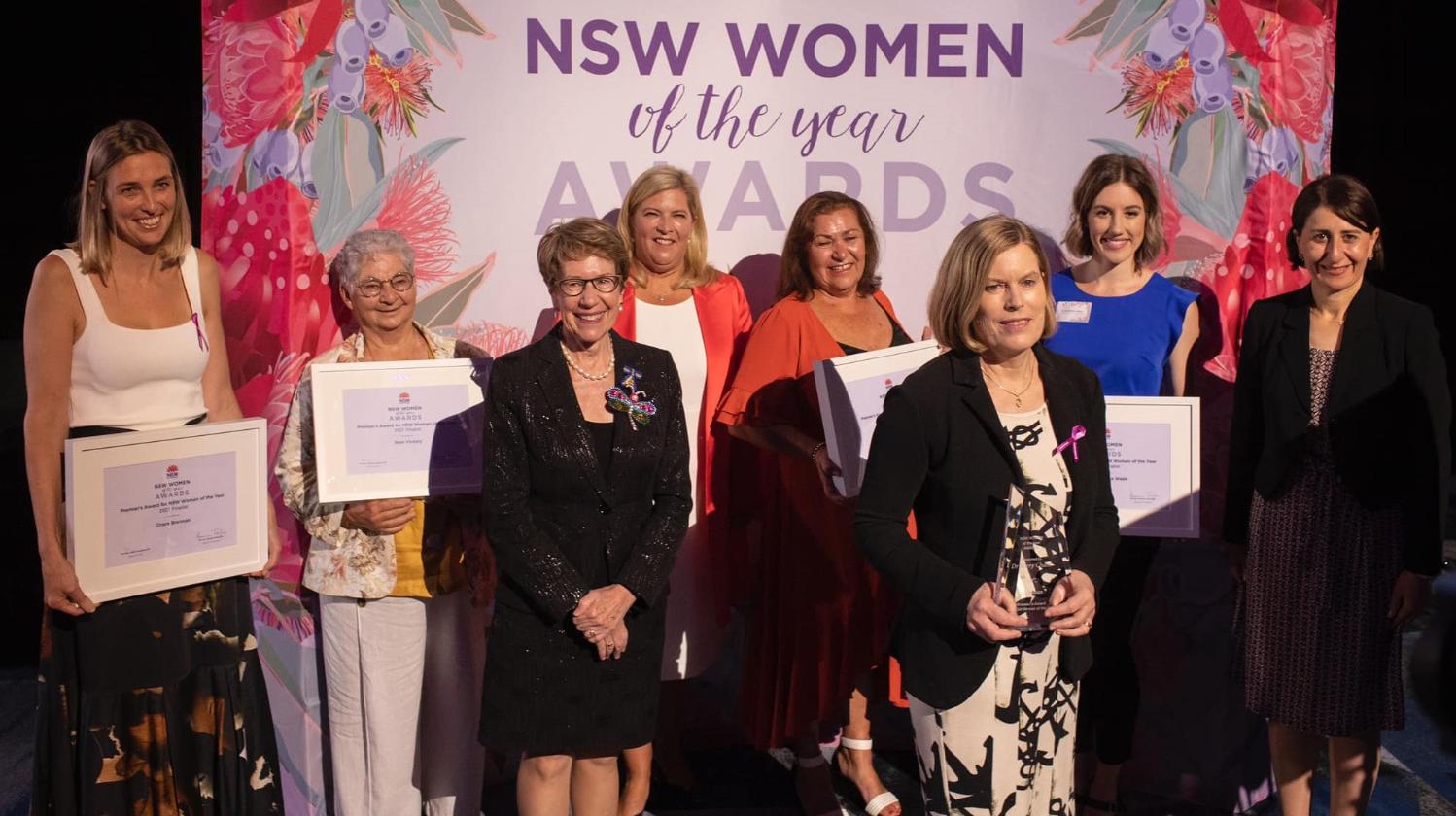
The COVID Recession Hit Women Hardest: New Grattan Report
- they lost more jobs than men – almost 8 per cent at the peak of the crisis, compared to 4 per cent for men;
- they shouldered more of the increase in unpaid work – including supervising children learning remotely – taking on an extra hour each day more than men, on top of their existing heavier load; and
- they were less likely to get government support – JobKeeper excluded short-term casuals, who in the hardest-hit industries are mostly women.
Homelessness In Older Women
400,000 women over 45 are at risk of homelessness in Australia

Older women have been recognised as the fastest-growing group of homeless people in Australia in recent years. Yet until now we have not known exactly how many older women are at risk of homelessness. Our research, released today, finds about 240,000 women aged 55 or older and another 165,000 women aged 45-54 are at risk of homelessness.
The startling data from our research give us a much better picture of the scale of the problem. We also quantify the impacts of the various factors that may increase women’s risk of becoming homeless.
Effective policy is grounded in quantifying the nature and complexity of issues. To date, a limited but growing number of studies have highlighted the experiences of older women who are homeless or at risk of homelessness. But few studies quantified the numbers at risk and the factors that increase the risk.
What Puts Women At Risk?

Older people are generally considered to be at less risk of homelessness because of their higher rates of home ownership. But increasingly unaffordable housing has added to concerns about the circumstances and living situations of older people who do not own homes, have limited wealth and savings and do not have the benefit of living in social housing. These households rely on the private rental market and are at considerable risk of housing affordability stress and hence homelessness.
Read more: Older and poorer: Retirement Income Review can't ignore the changing role of home
To examine risk profiles, we constructed an empirical model of risk of homelessness since the 2007-09 Global Financial Crisis using data from the Household, Income and Labour Dynamics in Australia (HILDA) Survey. The modelling included people who hold a mortgage or pay rent in private or public housing and are aged 45 or older.
This work found older women are more likely to be at risk of homelessness if they have one or more of the following characteristics:
• have been at risk before
• are not employed full-time
• are an immigrant from a non-English-speaking country
• are in private rental housing
• would have difficulty raising emergency funds
• are Indigenous
• are a lone-person household
• are a lone parent (but little evidence for those never married).
We estimated these profiles using a statistical model to analyse the relationship between homelessness risk and the characteristics of interest. We controlled for other characteristics that are likely to influence the risk of becoming homeless but which were not the focus of the study.
Risk Factors Compound Each Other
Multiple factors compound the risk of being homeless. While noting sampling limitations (small samples in subgroups of the data and annual volatility), the HILDA data for the post-GFC period suggest:
for women aged 55-64 in a private rental, about 28% are likely to be at risk
for women who are also not employed full-time the percentage at risk increases to about 34%
for those who are also a lone parent the risk rises to over 65%
the risk increases to over 85% if, in addition, they have experienced at least one prior occurrence of being at risk.
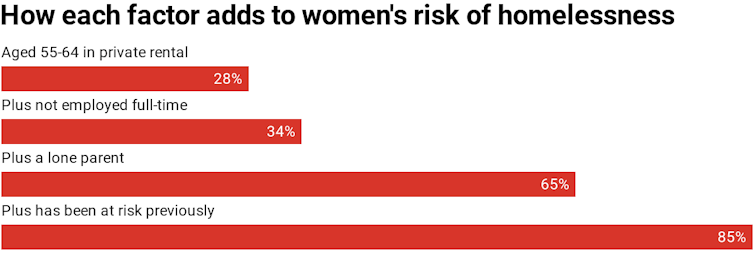
Clearly, a person’s propensity to be at risk of homelessness is cumulative over time.
Read more: More and more older Australians will be homeless unless we act now
Why The Numbers At Risk Will Grow
Our estimates of the numbers of people at risk are accurate to within plus or minus 10%. Based on Australian Bureau of Statistics population projections, it is clear that, without changes to policy, these numbers are likely to increase due to one important factor. The model shows a lone-person household is a dominant factor in increasing the likely risk of homelessness.
Lone-person households are expected to comprise 24-27% of all households by 2041. This equates to between 3.0 and 3.5 million Australians (of all ages). Female lone-person households are projected to increase by between 27.6% and 58.8% (ABS 2019b).
Australia has made little policy progress on housing affordability. We also have a severe shortage of social housing to meet demand. This points to the need to pursue other avenues to improve the lives of older low-income households.
Read more: What do single, older women want? Their 'own little space' (and garden) to call home, for a start
The Ageing on the Edge Older Persons Homelessness Prevention Project – funded by the JO and JR Wicking Trust and administered by Housing for the Aged Action Group (HAAG) – has worked over the past five years to give voice to these older women who are homeless or at risk of homelessness. The project works with interested agencies (government and non-government) to identify and promote early intervention and prevention strategies and to lobby for government policy change.
Of course, there is one simple answer to achieving long-term outcomes that allow people the basics of a decent older age: an appropriate affordable home.![]()
Debbie Faulkner, Senior Research Fellow, UniSA Business, University of South Australia and Laurence Lester, Senior Research Fellow, Centre for Housing, Urban and Regional Planning
This article is republished from The Conversation under a Creative Commons license. Read the original article.
No change at the top for university leaders as men outnumber women 3 to 1

Australian university leaders are nearly three times more likely to be a man than a woman.
Of 37 public university chancellors, just 10 are women (27%) and 27 (73%) are men. It’s exactly the same for vice-chancellors: 10 are women and 27 are men.
Together, this means men hold 54 of the 74 top jobs in Australian higher education.
Read more: Most of Australia's uni leaders are white, male and grey. This lack of diversity could be a handicap
Last year presented a big opportunity for progress towards gender equity among university leaders. During 2020, vice-chancellors at 15 of Australia’s 37 public universities either announced their departure from the role, or actually left. This move of 41% of the vice-chancellors in a single year provided the best opportunity for improving gender equity in living memory.
Unfortunately, Australian university councils, which appoint vice-chancellors, did not take up the opportunity. The gender ratio didn’t change at all.
To date, women have been appointed in just four of the 15 (27%) interim or ongoing replacements made. Two of these four women moved from one vice-chancellor position to another. In 11 of the 15 announced vice-chancellor replacements – 73% of cases – a man won the role.
Men also dominate the upper levels of Australian academia. The latest available figures (from 2019) show:
86% more men than women at associate professor and professor levels D and E (10,363 men, 5,562 women)
11% more men than women at senior lecturer level C (6,355 men, 5,724 women)
25% more women than men at lecturer level B (7,428 men, 9,253 women)
15% more women than men at associate lecturer level A (4,426 men and 5,093 women).
Overall, the numbers of men and women employed as academics aren’t very different. In 2019, Australian universities employed 54,204 full-time and fractional full-time academics: 28,572 men (53%) and 25,632 (47%) women. It’s the seniority of the positions they hold that differs starkly.
These figures do not include casual staff.
Isn’t The Gender Balance Improving?
Optimists often assure me leadership gender equity is improving. Granted, the percentage of female chancellors in Australian has increased in the past five years. In 2016, WomenCount reported 15% of Australian university chancellors were women. While the increase is positive, it remains disappointing that women occupy only about one-quarter of these increasingly powerful and important roles.
The shift in senior academic ranks has also been slow. In 2009, 73.5% of professors were men. Between 2009 and 2019, the proportion of female professors has risen from 26.5% to 35%. That’s an improvement of less than one percentage point per year on average.
At this rate, it will be the late 2030s before women make up half of the professoriate in Australia.
Read more: Female leaders are missing in academia
Why Does Gender Inequity Persist?
The most common reason put forward for gender inequity is related to women’s role in childbearing. But the fact that only women can grow, birth and breastfeed babies does not, on its own, explain why there are 86% more male associate professors and professors than women in these roles, nor why there are nearly three times more male than female vice-chancellors and chancellors. After all, these womanly activities take a relatively short amount of time and most women I know can skilfully multi-task while pregnant and breastfeeding.
However, the fact that women take on the bulk of child-raising duties might help explain the inequities. Of course, people of every gender can equally well raise children. But they don’t – it’s mostly left to the women.
Read more: Flexible work arrangements help women, but only if they are also offered to men

For women, the results of this unequal sharing of responsibility include:
less time and energy for academic pursuits
more teaching (often) and less time for research and publishing
lower academic and leadership profiles (usually)
fewer opportunities to engage in activities that count for promotion and for senior leadership roles.
Of course, not all women have children. And those that do find that they grow up, learn to feed, dress and eventually support themselves and move out of home. Is it also possible that Australian university culture and practices privilege men’s careers and hold back women’s advancement?
University decision-makers, including promotion committees, might well favour men because of:
relatively uninterrupted and neat career trajectories
relatively greater freedom to engage in research and publishing without the disadvantages of part-time employment, never mind the mid-afternoon school run
more easily quantified outputs
more frequent opportunities to lead
the cumulative achievements, profile and trajectory that come with all of the above.
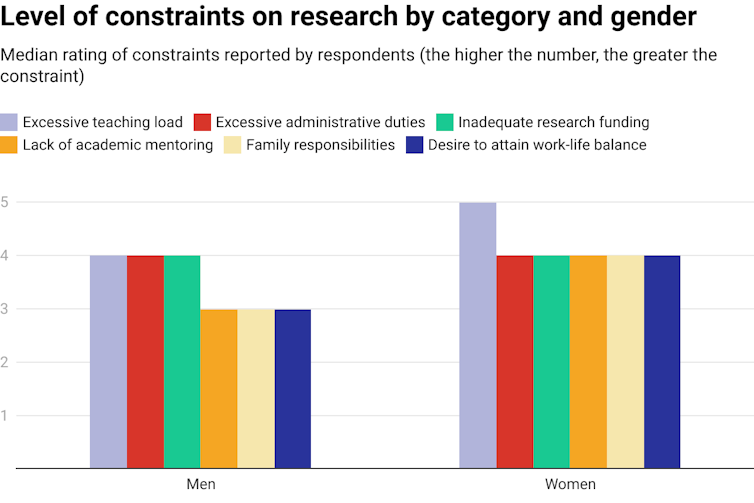
Read more: How COVID is widening the academic gender divide
Let’s Shake Up The Status Quo
Most universities try to redress gender inequity. Committees, agenda items, plans, targets and mentoring programs abound. But evidently these efforts aren’t working.
After many years in executive and governance leadership, I continue to observe decision-makers often thinking of men first, or only of men, when searching for suitable leadership candidates.
On the rarer occasions that women are offered leadership opportunities, they have to adopt the “right” style and carefully balance gravitas and humility. They must learn how to perform gender judo and ensure they don’t fall into the success versus likeability conundrum that Facebook chief operating officer and author Sheryl Sandberg made famous.
In short, to become academic leaders, women must skilfully navigate the unconscious bias and sexism that permeate universities.
While shifts are occurring, they are painfully slow, as the gender data over the past decade and predicted trajectories show. Might it be time for women (and enlightened men) to take matters into their own hands to begin to undermine the status quo? I think so – so I’ve written a book that proposes techniques to adopt to these ends.
What will you do to contribute to greater gender equity?![]()
Marcia Devlin, Adjunct Professor, Victoria University
This article is republished from The Conversation under a Creative Commons license. Read the original article.
Successful Trial Shows Way Forward On Quieter Drone Propellers
Researchers Develop Improved Recycling Process For Carbon Fibres
Research Shows We're Surprisingly Similar To Earth's First Animals
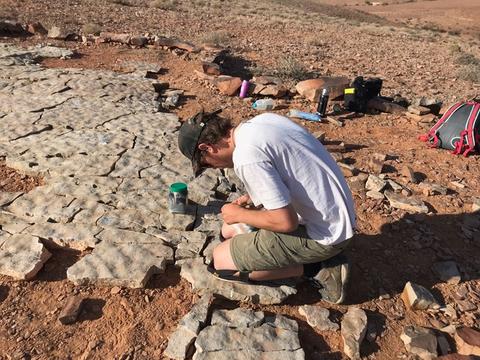
Northern Hemisphere Summers May Last Nearly Half The Year By 2100
Disclaimer: These articles are not intended to provide medical advice, diagnosis or treatment. Views expressed here do not necessarily reflect those of Pittwater Online News or its staff.
